Base
This chapter describes the key features of the [Base] menu in OpenFrame Manager.
1. Overview
[Base] provides a set of management functions for OpenFrame/Base system. This includes looking up volume information, cataloged dataset information, locked datasets, and OpenFrame logs.
Click [Base] at the top and then click a menu from the left navigation pane.
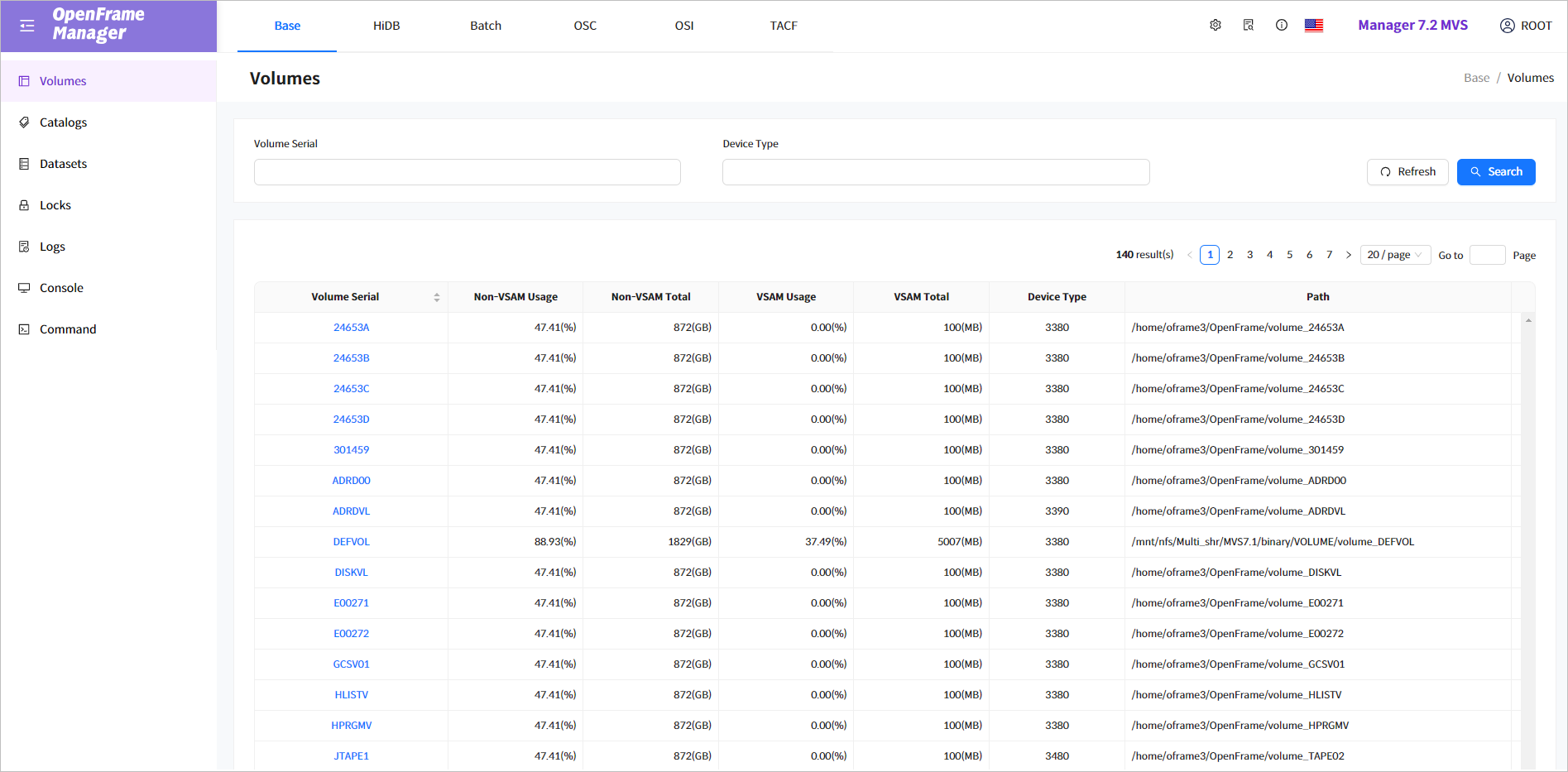
The following describes the menus in the navigation pane.
| Menu | Description |
|---|---|
Display a list of volumes. |
|
Display a list of catalogs. |
|
Display a list of datasets, and add, edit, or delete a dataset or GDG. |
|
Display a list of locks set in OpenFrame. |
|
Display OpenFrame system logs. |
|
Print messages generated during JOB or COBOL executions, view history, or send replies. |
|
Use Linux shell commands or OpenFrame tool commands. |
2. Volumes
Click Volumes from the navigation pane to display information on all volumes in the OpenFrame/Base system. Enter the search conditions from the Volumes page and then click [Search] to display the results. Click [Refresh] above the list to refresh the list.

-
Search Conditions
The following describes the volume search conditions. Use wildcard (*) in searches (e.g: DEF*, 33*).
Item Description Volume Serial
Volume serial name.
Device Type
Unit device type, such as 3380, 3390, 3390A, and 3480.
-
Search Results
The following describes the search result columns.
Column Description Volume Serial
Volume serial name. Click this to go to the Volume Details page ([Base] - Volumes - Volume Details). For more information, refer to Volume Details Page.
Non-VSAM Usage
Percentage of the space used by Non-VSAM datasets in the volume. (Unit: %)
Non-VSAM Total
Disk space allocated to Non-VSAM datasets in the volume. (Unit: GB, MB if < 100 GB)
VSAM Usage
Percentage of the space used by VSAM datasets in the volume. (Unit: %)
VSAM Total
Disk space allocated to VSAM datasets in the volume. (Unit: GB, MB if < 100 GB)
Device Type
Unit device type, such as 3380, 3390, 3390A, and 3480.
Path
Unix path of the volume serial.
2.1. Volume Details Page
Select a volume from the Volumes list in the Volumes page ([Base] - Volumes) to view its information.
Volume Details page displays information about the volume and its datasets. Click a dataset name to view its information. Click the [<] icon before the page title to return to the previous page.
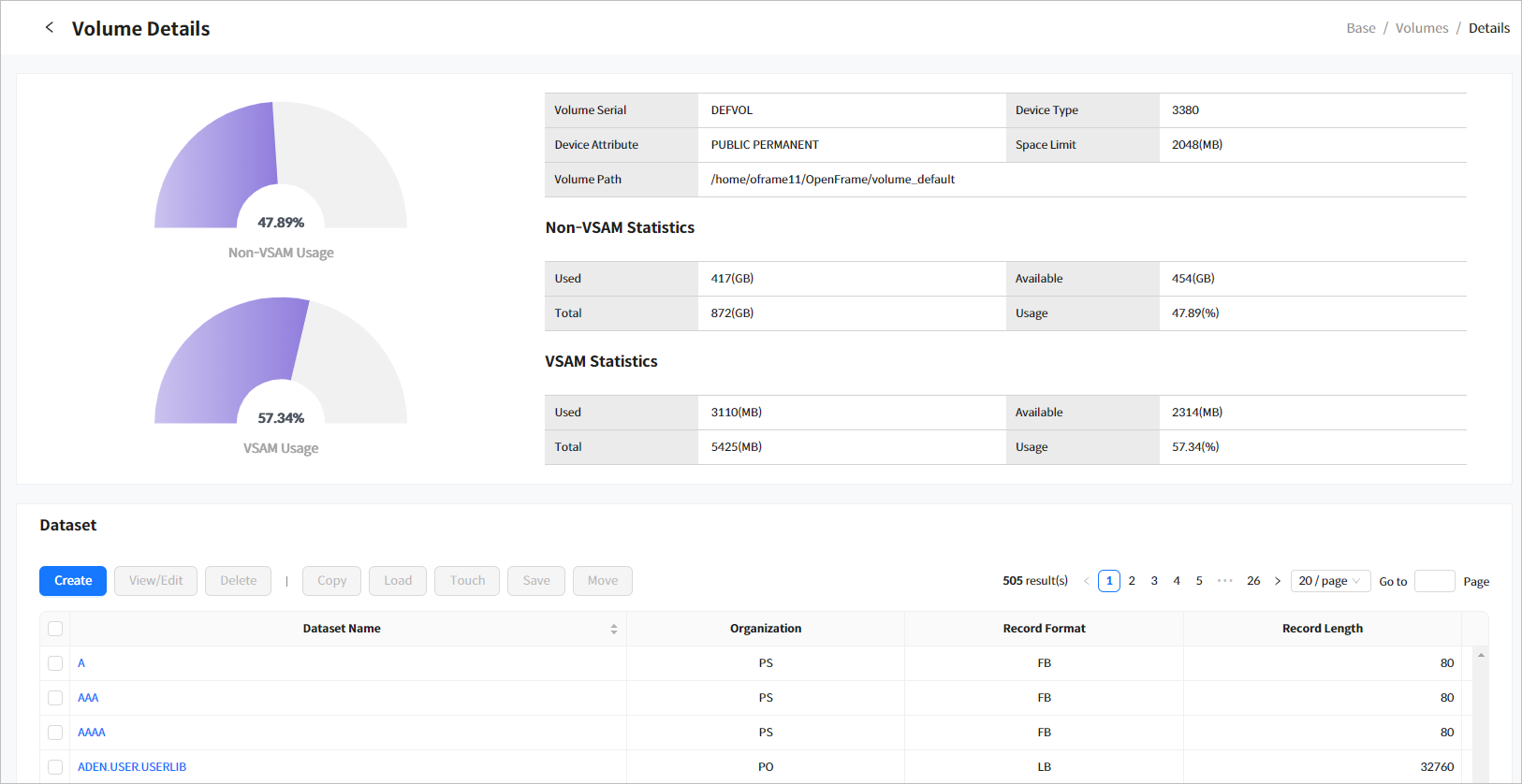
-
Volume Information
The following describes each item in the volume information section.
Item Description Angular Chart
Percentage of the volume space in use in an angular chart.
Volume Serial
Volume serial name.
Device Type
Unit device type, such as 3380, 3390, 3390A, and 3480.
Device Attribute
Use attribute (PRIVATE, PUBLIC, or STORAGE) and mount attribute (PERMANENT or REMOVABLE).
Space Limit
Maximum size of datasets in the volume and tablespace.
Volume Path
Unix path of the volume serial.
Used
Disk space used by Non-VSAM/VSAM datasets in the volume. (Unit: GB, MB if < 100 GB)
Available
Available disk space that can be allocated to Non-VSAM/VSAM datasets in the volume. (Unit: GB, MB if < 100 GB)
Total
Disk space allocated to Non-VSAM/VSAM datasets in the volume. (Unit: GB, MB if < 100 GB)
Usage
Percentage of the space used by Non-VSAM/VSAM datasets in the volume. (Unit: %)
-
Datasets
The following describes each item in the Dataset list.
Item Description Dataset Name
Dataset name. Click this to go to the Dataset Details page ([Base] - Dataset Details (NONVSAM)). For more information, refer to Dataset Details Page.
Organization
Dataset organization.
-
PS (Physical Sequential)
-
IS (Indexed Sequential)
-
PO (Partitioned)
-
DA (Direct)
Record Format
Record format (RECFM).
Uses FB and VB formats for block I/O support (VS or VBS for spanned records).
-
F: Fixed-length
-
FB: Fixed-length blocked
-
V: Variable-length
-
VB: Variable-length blocked
-
L: Line-sequential
-
LB: Line-sequential blocked
-
U: Undefined
Record Length
Record length (LRECL). This is set to the maximum allowed record length for variable-length or undefined format.
-
-
Buttons
The following describes each button.
Button Description [Create]
Adds a dataset in Create Dataset ([Base] - Create Dataset - [Create Dataset] Tab). For more information, refer to Creating a Dataset. (Non-VSAM, GDG, VSAM)
[View/Edit]
Displays and modifies datasets by column. For more information, refer to Editing a Dataset. (Non-VSAM, VSAM)
[Delete]
Delete single or multiple dataset selected from a dataset list. For more information, refer to Deleting Datasets.
[Copy]
Copies a dataset selected from a dataset list. For more information, refer to Managing Datasets. (Non-VSAM)
[Load]
Loads a dataset selected from a dataset list into a specified temporary directory as a Unix file. For more information, refer to Managing Datasets. (Non-VSAM)
[Touch]
Updates the last access date of a dataset selected from a dataset list. For more information, refer to Managing Datasets. (Non-VSAM)
[Save]
Saves a dataset selected from a dataset list. For more information, refer to Managing Datasets. (Non-VSAM)
[Move]
Moves a dataset selected from a dataset list and changes its name. For more information, refer to Managing Datasets. (Non-VSAM)
3. Catalogs
Click Catalogs from the navigation pane to display a list of catalogs.
Enter the search conditions from the Catalogs page and then click [Search] to display the results. To refresh the list, click [Refresh] above the list.

-
Search Conditions
The following describes the catalog search conditions.
Item Description Catalog Name
Enter Catalog name.
Volume Serial
Enter Volume serial name.
-
Search Results
The following describes the search result columns.
Column Description Catalog Name
Displays Catalog name.
Click this to go to the Datasets page ([Base] - Datasets). For more information, refer to Datasets.
Type
Displays Catalog type.
-
MASCAT: master catalog
-
UCAT: user catalog
Volume Serial
Displays Volume serial name.
Click this to go to the Volume Details page ([Base] - Volumes - Volume Details). For more information, refer to Volume Details Page.
Master Catalog Name
Displays Master catalog name.
Click this to go to the Datasets page ([Base] - Datasets). For more information, refer to Datasets.
-
4. Datasets
Click Datasets from the navigation pane to display a list of datasets for a volume or catalog, and create a new dataset or GDG. Initially, the page loads with datasets for catalog. Click [Refresh] to refresh the list.
Select 'Catalogs' or 'Volumes' from the 'Catalog Name' combo box, enter a search condition, and then click [Search] to display the results. If you change the option, the search fields are repopulated.
You can manage datasets by using buttons above the list. The buttons are enabled or disabled according to the selected dataset type.
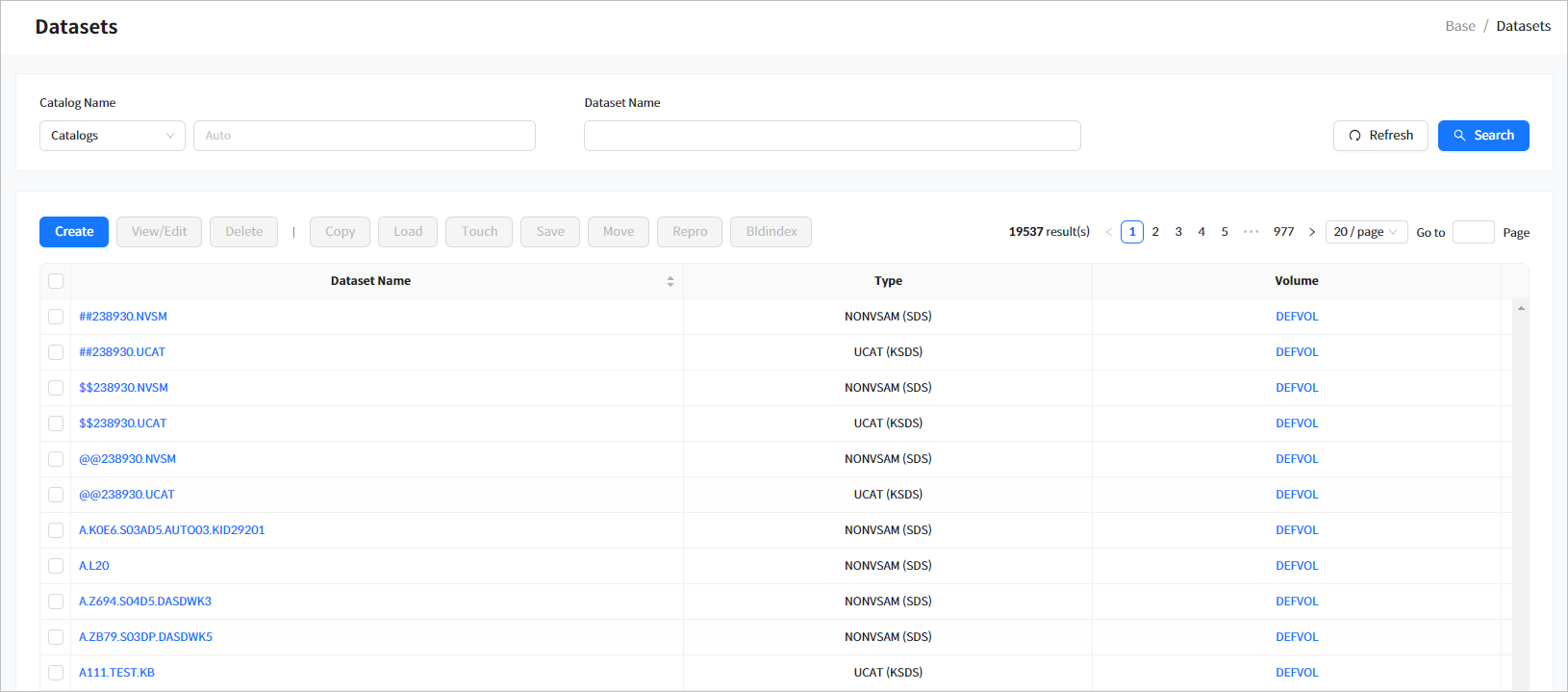
-
Search Conditions
The following describes the dataset search conditions.
Item Description Catalog Name / Volume Serial
Enter catalog or volume name to search.
-
Catalog Name: The default value is Auto. If Auto is selected and an alias is used according to a dataset name, a catalog that matches the alias is searched. Otherwise, the master catalog is searched.
-
Volume Serial: If not specified, the default value is set to the DEFAULT_VOLSER key value of the DATASET_DEFAULT section in the ds subject in the openframe_base.conf file.
Dataset Name
Enter dataset name to search. If 'XXX*' is entered, all datasets that start with 'XXX' are retrieved by using the wildcard search method.
For more information about openframe_base.conf file, refer to OpenFrame Configuration Guide.
-
-
Search Results
The following describes the search result columns according to the selected option (Catalogs or Volumes).
-
Catalog list
Column Description Dataset Name
Dataset name. Click this to go to the Dataset Details page ([Base] - Dataset Details (NONVSAM)). For more information, refer to Dataset Details Page.
Type
Dataset type.
-
NONVSAM (SDS)
-
NONVSAM (PDS)
-
NONVSAM (GDS)
-
CLUSTER (KSDS)
-
CLUSTER (ESDS)
-
CLUSTER (RRDS)
-
UCAT (KSDS)
-
AIX (KSDS)
-
ALIAS
-
PATH
-
GDG
Volume
Volume serial name. Click this to go to the Volume Details page ([Base] - Volumes - Volume Details). For more information, refer to Volume Details Page.
-
-
Volume list
Column Description Dataset Name
Dataset name. Click this to go to the Dataset Details page ([Base] - Dataset Details (NONVSAM)). For more information, refer to Dataset Details Page.
Organization
DSORG of the dataset.
-
PO (Partitioned)
-
PS (Physical Sequential)
-
IS (Indexed Sequential)
-
DA (Direct Access)
Record Format
RECFM (record format) of the dataset.
-
F: Fixed-length
-
FB: Fixed-length blocked
-
V: Variable-length
-
VB: Variable-length blocked
-
L: Line-sequential
-
LB: Line-sequential blocked
Record Length
Maximum record length of the dataset.
-
-
-
Buttons
The following describes each button.
Button Description [Create]
Adds a dataset in Create Dataset ([Base] - Create Dataset - [Create Dataset] Tab). For more information, refer to Creating a Dataset. (Non-VSAM, GDG, VSAM)
[View/Edit]
Displays and modifies datasets by column. For more information, refer to Editing a Dataset. (Non-VSAM, VSAM)
[Delete]
Delete single/multiple dataset selected from a dataset list. For more information, refer to Deleting Datasets.
[Copy]
Copies a dataset selected from a dataset list. For more information, refer to Managing Datasets. (Non-VSAM)
[Load]
Loads a dataset selected from a dataset list to a specified temporary directory as a Unix file. For more information, refer to Managing Datasets. (Non-VSAM)
[Touch]
Updates the last access date of a dataset selected from a dataset list. For more information, refer to Managing Datasets. (Non-VSAM)
[Save]
Saves a dataset selected from a dataset list. For more information, refer to Managing Datasets. (Non-VSAM)
[Move]
Moves a dataset selected from a dataset list or changes its name. For more information, refer to Managing Datasets. (Non-VSAM)
[Repro]
Copies contents of a dataset selected from a dataset list. For more information, refer to Managing Datasets. (VSAM)
[Bldindex]
Configures secondary indexes of a dataset selected from a dataset list. For more information, refer to Managing Datasets. (VSAM)
4.1. Dataset Details Page
Click a dataset name from the Datasets list in the Datasets page ([Base] - Datasets) to view its information. Click the [<] icon before the page title to return to the previous page.

The Dataset Details page consists of the following section.
Dataset Information
The pages and items are different depending on dataset types (NONVSAM, VSAM, PATH, GDG, and ALIAS).
The following shows pages by dataset type.
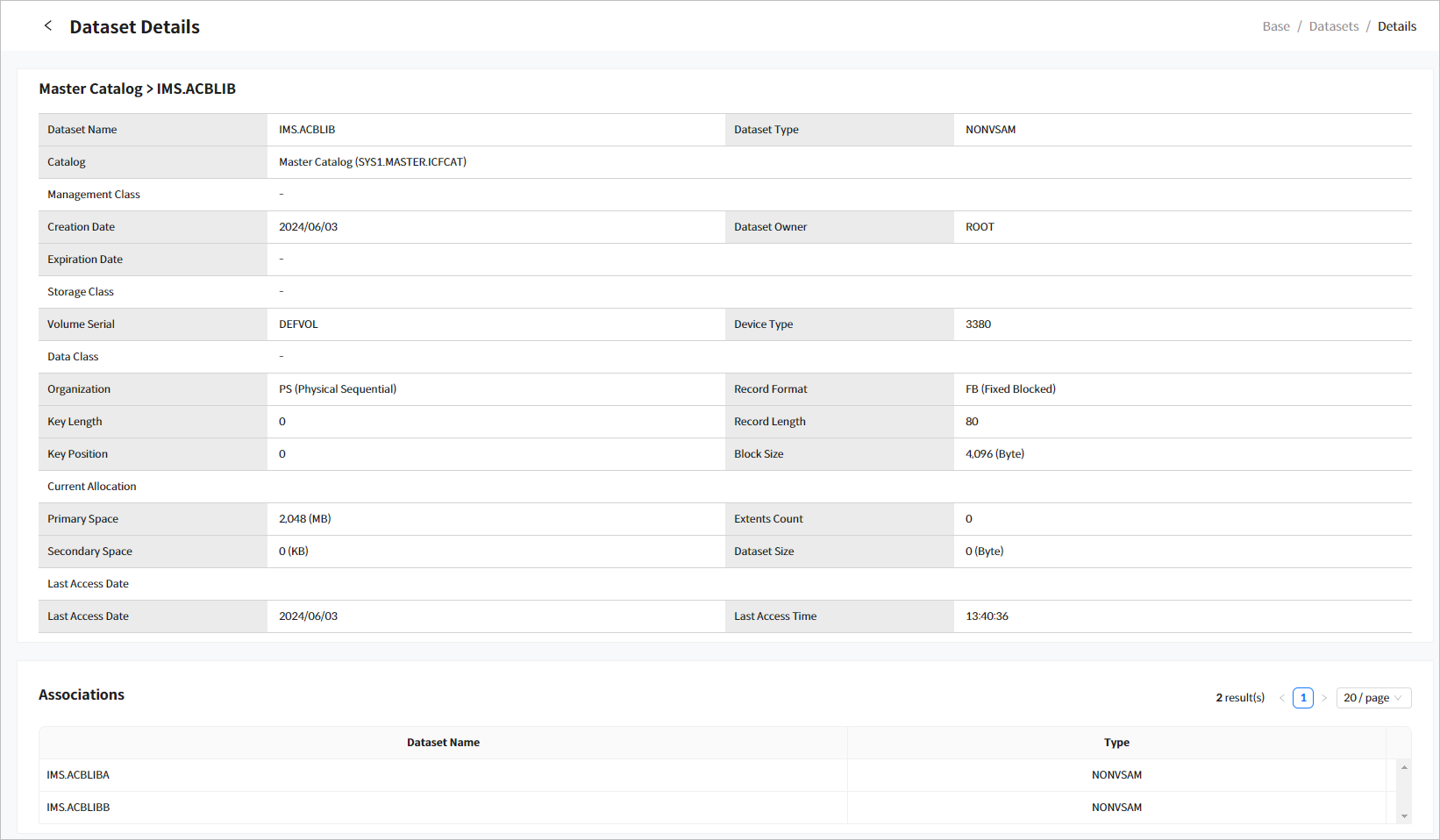
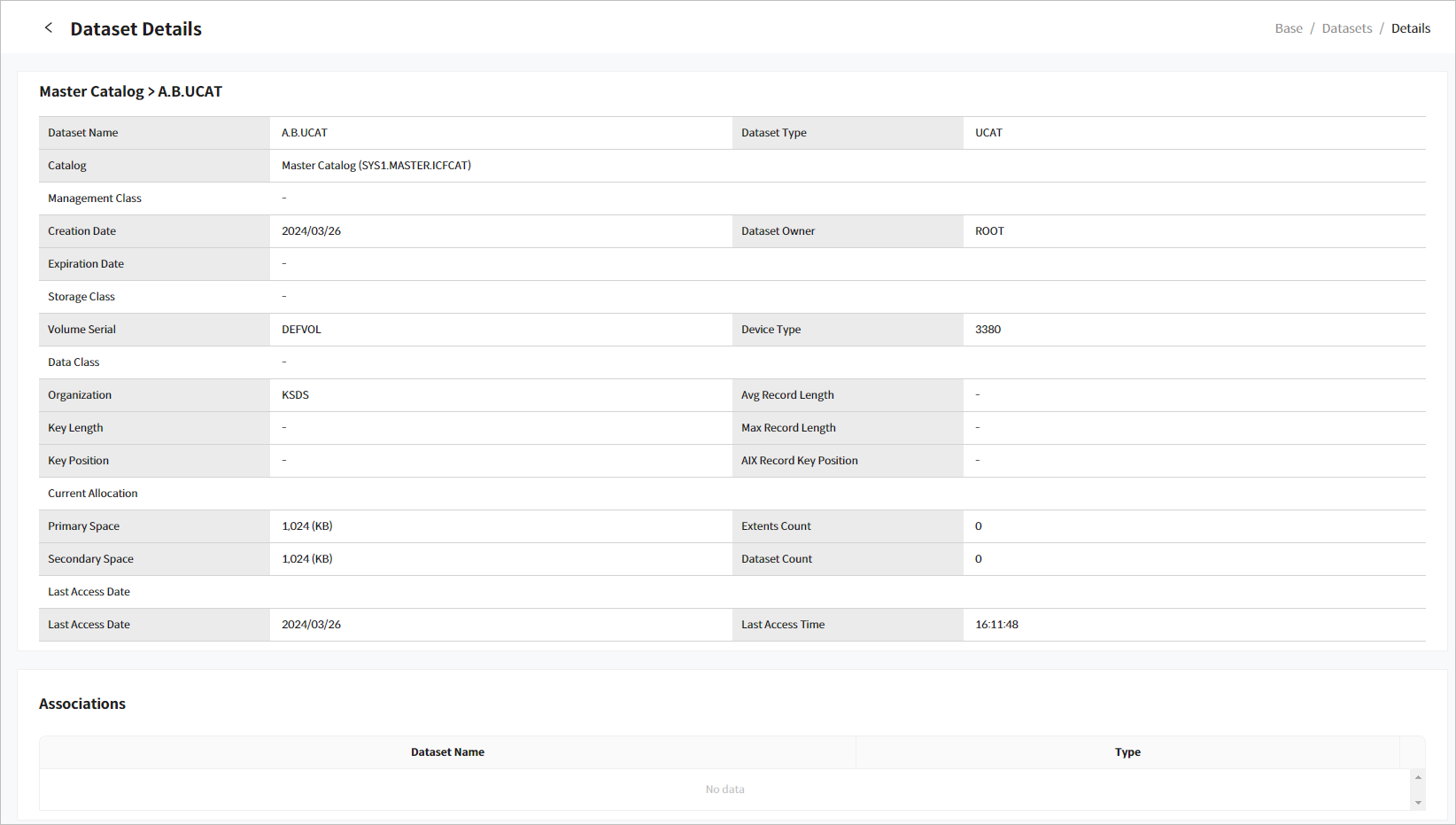

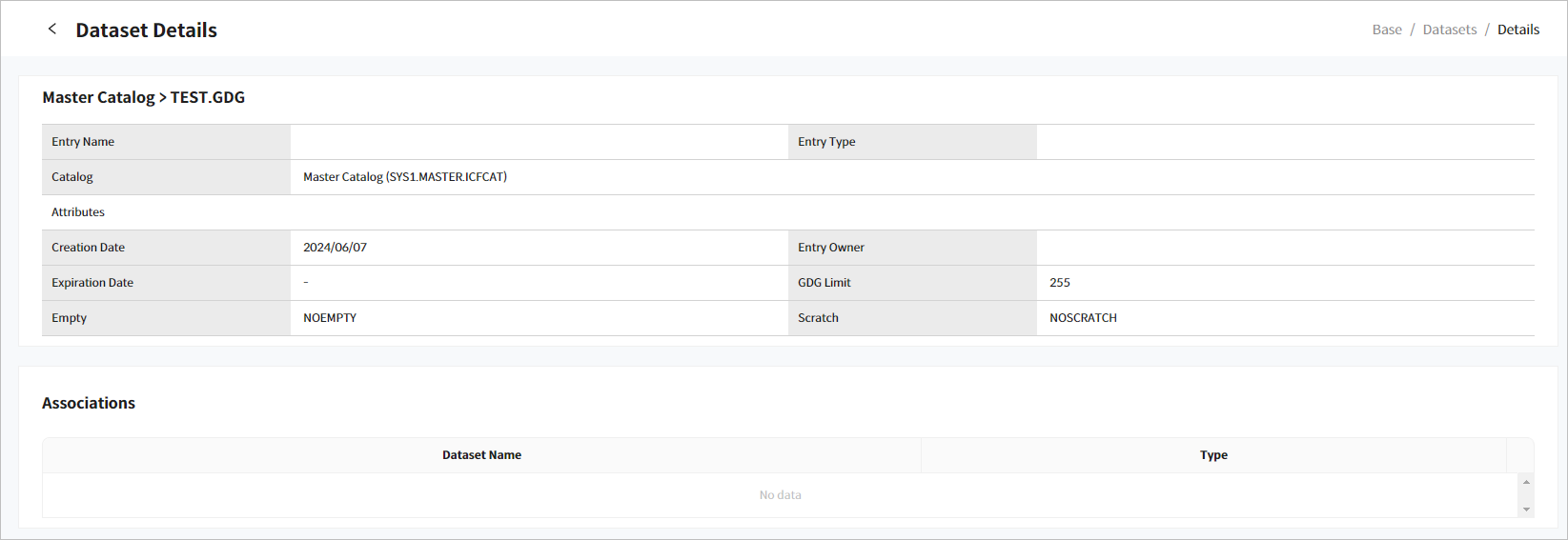

The following describes each item. Displayed items vary by dataset type.
| Item | Description | |
|---|---|---|
Dataset Name |
Dataset/entry name. |
|
Dataset Type |
Dataset/entry type. - NONVSAM - UCAT - CLUSTER - AIX - ALIAS - PATH - GDG |
|
Catalog |
Catalog name. This is only displayed when this page is accessed from the Datasets list populated with Search in set to 'Catalogs'. A master catalog name is enclosed in parentheses. |
|
Management Class |
Management class to use to create the dataset. |
|
Creation Date |
Dataset creation date (yyyy/MM/DD). |
|
Dataset Owner |
Owner of the dataset file. |
|
Expiration Date |
Dataset expiration date (yyyy/MM/DD). |
|
Storage Class |
Storage class to use to create the dataset. |
|
Volume Serial |
Volume serial specified at dataset allocation. |
|
Device Type |
Device type. |
|
Data Class |
Data class to use to create the dataset. |
|
Organization |
DSORG of the dataset. |
|
Record Format |
RECFM (record format) of the dataset. |
|
Key Length |
Dataset key length. |
|
Record Length |
Maximum record length of the dataset. |
|
Key Position |
Dataset key position. |
|
Block Size |
Maximum allowed block size. (Unit: byte) |
|
AVG Record Length |
Average record length of the dataset. This is only available when Dataset Type is UCAT, CLUSTER, or AIX. |
|
MAX Record Length |
Maximum record length of the dataset. This is only available when Dataset Type is UCAT, CLUSTER, or AIX. |
|
AIX Record Key Position |
Key position of AIX record. This is only available when Dataset Type is UCAT, CLUSTER, or AIX. |
|
Current Allocation |
Primary Space |
Initial amount of space allocated for the dataset. (Unit: KB, MB, GB, TB, or PB) |
Extents Count |
Number of extents specified for dataset allocation. If Dataset Type is UCAT, CLUSTER, or AIX, 'N.A' will be displayed. |
|
Secondary Space |
Space allocated for the dataset after the initial allocation. (Unit: KB, MB, GB, TB, or PB) |
|
Dataset Size |
Dataset size. (Unit: byte) |
|
Dataset Count |
Number of datasets. This is only available when Dataset Type is UCAT, CLUSTER, or AIX. |
|
Last Access Date |
Last Access Date |
Last date the data was accessed. |
Last Access Time |
Last time the data was accessed. |
|
Attributes |
GDG Limit |
Maximum number of generations allowed in GDG. This is only displayed for GDGs. This is only available when Dataset Type is GDG. |
Empty |
Empty specifies to uncatalog all existing generations of the GDG when the maximum limit for the GDG is reached. NOEMPTY specifies to uncatalog only the oldest generation of the GDG when the limit is reached. This is only available when Dataset Type is GDG. |
|
Scratch |
Scratch specifies to physically delete the dataset when it is uncataloged according to the EMPTY/NOEMPTY parameter option. NOSCRATCH specifies to only uncatalog the entry without physically deleting it. This is only available when Dataset Type is GDG. |
|
Associations

The following describes each item.
| Item | Description |
|---|---|
Dataset Name |
Name of the associated dataset. |
Type |
Type of the associated dataset.
|
Members
If the dataset has a partitioned organization (PO), the dataset is created as a directory. The files in the directory are called members and the user can add a file as a member.

-
Search Conditions
To search member datasets, enter a keyword in the search field of 'Members'. Since the LIKE search method is used, do not use a wildcard (*).
-
Search Results
The following describes the search result columns.
Column Description Member Name
File name in the PO dataset.
Dataset Owner
Owner of index file.
Size (Byte)
Record size of the alternate index. (average, maximum)
Last Access Date/Time
Last date/time the dataset was accessed.
-
Button
The following describes the page buttons.
-
[Delete]
Dataset is deleted by clicking the [OK] button in the following dialog box.
 [Base] - Dataset Details - Members - Delete
[Base] - Dataset Details - Members - Delete -
[Copy]
Dataset is copied to the target PDS by entering a target PDS name and clicking the [OK] button in the following dialog box.
 [Base] - Dataset Details - Members - Copy
[Base] - Dataset Details - Members - CopyTo delete members at once, USE_PDSE_SHARING=YES must be set under the DATASET_DEFAULT section in ds subject of openframe_base.conf file. If 'USE_PDSE_SHARING = NO' is set or the configuration is commented out, the members may be locked and not be deleted at once. For more information about openframe_base.conf file, refer to OpenFrame Configuration Guide.
-
-
Member View
The member dataset of general PDS is viewed through a dialog message when it’s name is clicked. JCL related PDS can be viewed by moving to the JCL page.
-
When the member dataset of general PDS is clicked
 [Base] - Dataset Details - Members - Normal Member
[Base] - Dataset Details - Members - Normal Member -
When the JCL-related PDS member dataset is clicked
 [Base] - Dataset Details - Members - JCL Member
[Base] - Dataset Details - Members - JCL Member
-
4.2. Creating a Dataset
To add a dataset, click [Create] above the dataset list in Datasets ([Base] - Datasets). Select one of the tabs ([Create Dataset], [Create GDG], and [Create VSAM]) according to the dataset type.
[Create Dataset] Tab
Creates a general dataset. Enter the required fields and then click [Create].
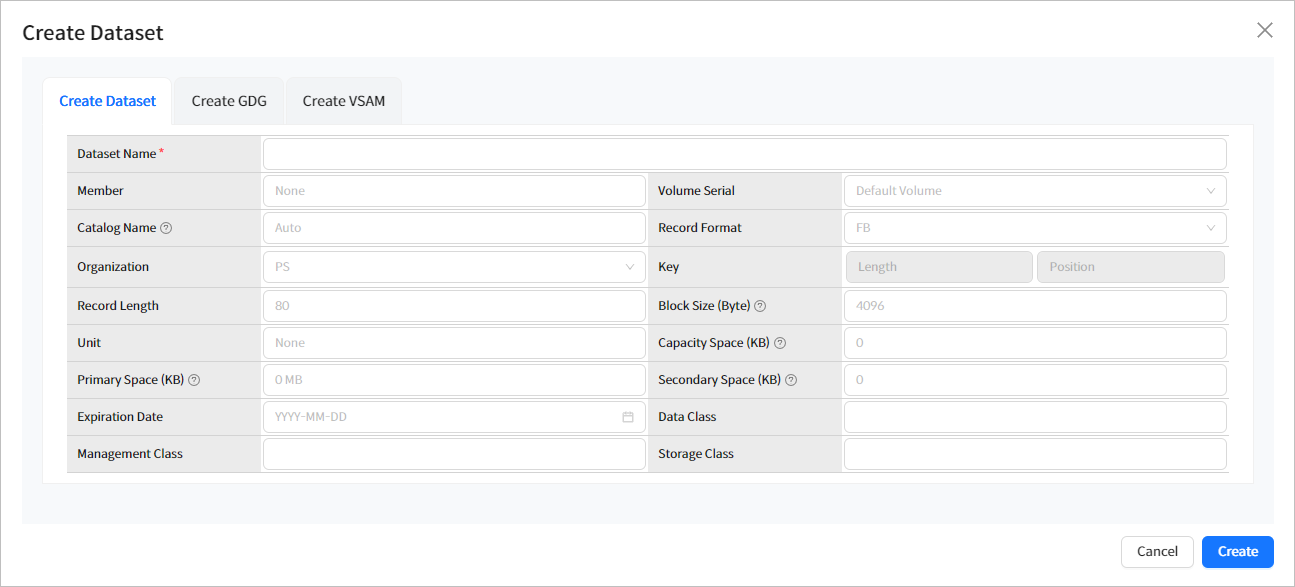
The following describes each item.
| Item | Description |
|---|---|
Dataset Name |
Enter dataset name (DSN). (Required) Dataset naming conventions:
|
Member |
Enter dataset member name. This is only applicable when adding a member to an existing PO dataset which must be specified in the Dataset Name field. (Default value: None) Enter dataset naming conventions:
|
Volume Serial |
Select volume serial name for the dataset. The default value is 'Default Volume,' and the value is set according to the 'DEFAULT_VOLSER' item under the [DATASET_DEFAULT] section of openframe_base.conf file. |
Catalog Name |
Select catalog name for the dataset.
|
Record Format |
Select dataset record format.
|
Organization |
Select dataset organization.
|
Key |
Set key length and position of the dataset.
This is required for ISAM datasets if the 'Organization' item is set to IS. If it is not set to IS, the 'Length' and 'Position' items are disabled. |
Record Length |
Set the maximum record length. If no value or 0 is set, the default value is used. (Default value: 80, range: 0-32760) |
Block Size |
Set dataset block size. If no value or 0 is set, the default value is used. (Default value: 4096, range: 0-2097152, Unit: Byte) |
Unit |
Set dataset unit. (Default value: None) |
Capacity Space |
Enter disk space for the dataset. (Unit: KB)
|
Primary Space |
Set initial amount of space allocated for the dataset. (range: 0-65535, Unit: KB) |
Secondary Space |
Set additional space allocated for the dataset after the initial allocation. (range: 0-65535, Unit: KB) |
Expiration Date |
Set dataset expiration date. 'None' (no expiration) is set by default. |
Data Class |
Set data SMS class. Set the class defined in the DATACLAS section in sms subject of openframe_base.conf file. |
Management Class |
Set management SMS class. Set the class defined in the MGMTCLAS section in sms subject of openframe_base.conf file. |
Storage Class |
Set storage SMS class. Set the class defined in the STORCLAS section in sms subject of openframe_base.conf file. |
|
[Create GDG] Tab
Creates a GDG dataset. Enter the required fields and then click [Create].

The following describes each item. For more information about each item, refer to "3.13.gdgcreate" in OpenFrame Tool Reference Guide.
| Item | Description |
|---|---|
Dataset Name |
GDG Dataset name. (Required) For GDG dataset naming conventions, refer to the description in [Create Dataset] Tab. |
Catalog Name |
Catalog name for the GDG dataset. (Default value: Master Catalog) |
Generation Limit |
Maximum number of GDG entries. (Default value: 255, range: 1-255) |
Expiration Date |
Dataset expiration date. (Default value: None) |
Empty |
Range to uncatalog when the maximum limit for the GDG is reached. Select one of:
|
Scratch |
Action to take for the GDS when it is uncataloged according to the EMPTY/NOEMPTY parameter option. Select one of:
[Note] If a value is set in the 'GDG_SCRATCH_DEFAULT' item under the DATASET_DEFAULT section in ds subject of openframe_base.conf file, the value is the default value. For more information, refer to OpenFrame Configuration Guide. |
[Create VSAM] Tab
Creates a VSAM dataset. Select an option among USER CATALOG, ALIAS, CLUSTER, ALTERNATE INDEX, and PATH, enter the required fields and then click [Generate JCL] to generate a JCL for creating the VSAM in the JCL View. Click [Create] to execute the JCL that submits the job and creates the dataset.
The following describes input items for each option. For detailed information about each item, refer to the "1.4. IDCAMS" section in OpenFrame Utility Reference Guide.
-
USER CATALOG
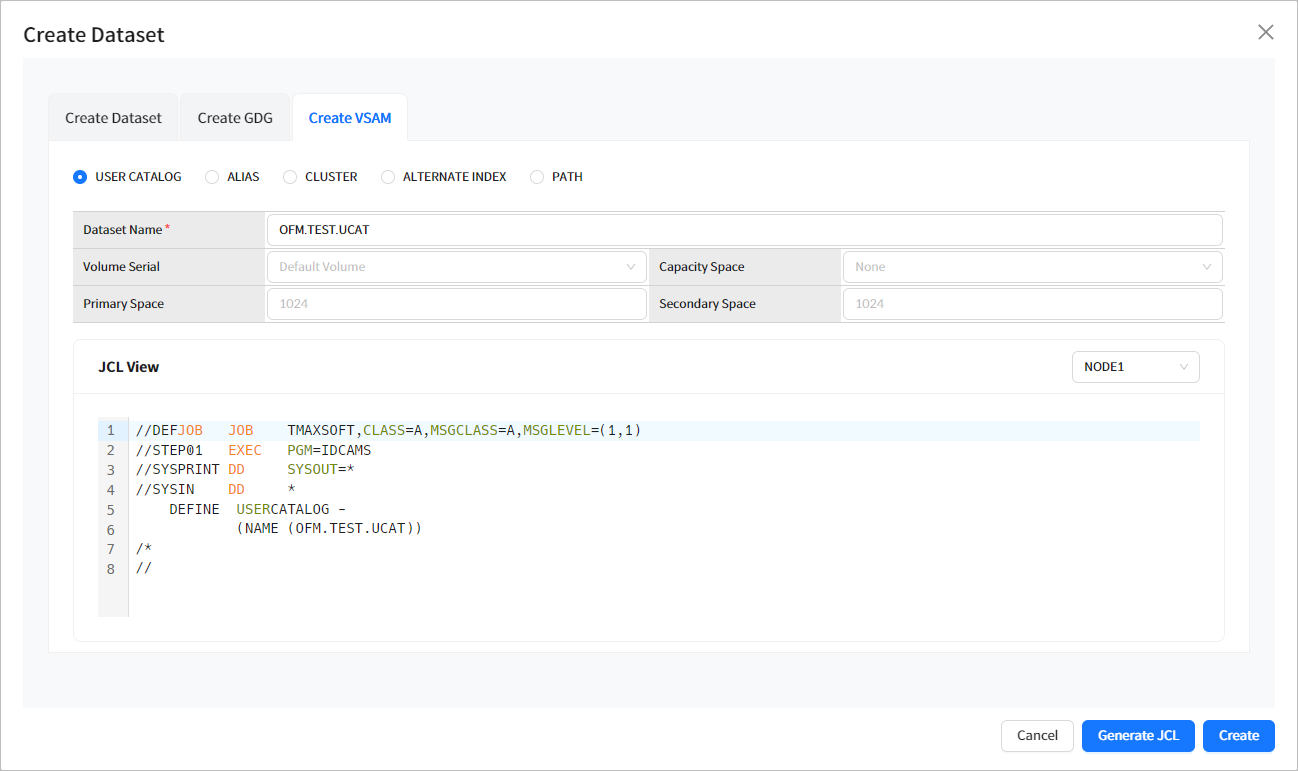 [Base] - Create Dataset - [Create VSAM] Tab (USER CATALOG)
[Base] - Create Dataset - [Create VSAM] Tab (USER CATALOG)The following describes each item.
Item Description Dataset Name
User catalog name for the dataset. (Required)
Volume Serial
Volume serial name to save the catalog in.
Capacity Space
Select one of:
-
None (Default value)
-
CYLINDERS
-
KILOBYTES
-
MEGABYTES
-
RECORDS
-
TRACKS
Primary Space
Initial amount of space allocated for the dataset. (Default value: 1024)
Secondary Space
Space allocated for the dataset after the initial allocation. (Default value: 1024)
-
-
ALIAS
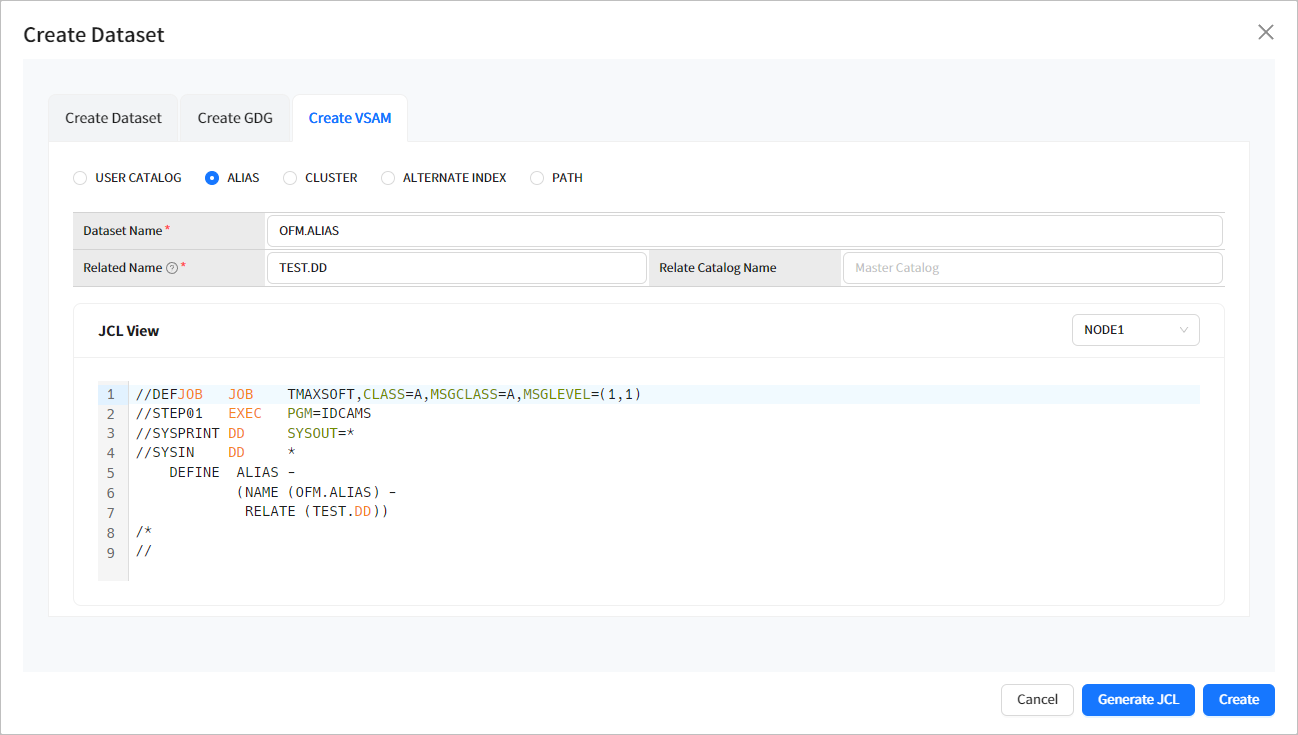 [Base] - Create Dataset - [Create VSAM] Tab (ALIAS)
[Base] - Create Dataset - [Create VSAM] Tab (ALIAS)The following describes each item.
Item Description Dataset Name
Alias. (Required)
Related Name
Entry name of the alias. (Required)
Related Catalog Name
Catalog of the entry. (Default value: Master Catalog)
-
CLUSTER
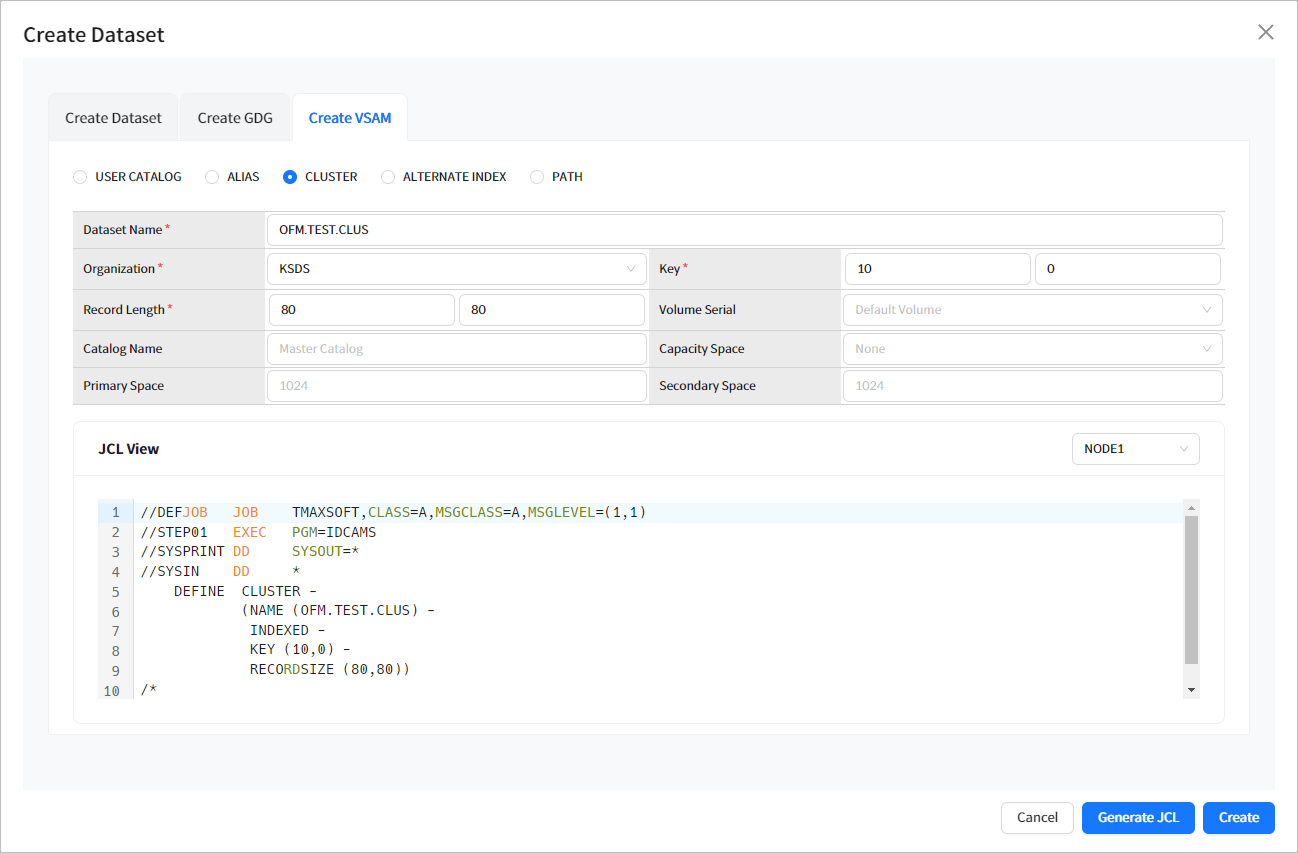 [Base] - Create Dataset - [Create VSAM] Tab (CLUSTER)
[Base] - Create Dataset - [Create VSAM] Tab (CLUSTER)The following describes each item.
Item Description Dataset Name
Cluster name. (Required)
Organization
Dataset organization. (Required)
Select one of:
-
KSDS
-
ESDS
-
RRDS
Key
Key position and length of a record in an indexed VSAM dataset.
-
Length (Default value: 0, range: 0-255)
-
Position (Default value: 0, range: 0-32760)
This is applicable and required only when the 'Organization' item is KSDS.
Record Length
Average and maximum length of a record. (Required)
-
Average (Range: 0-32760)
-
Max (Range: 0-32760)
Volume Serial
Volume serial name for the dataset.
The default value is set to the 'DEFAULT_VOLSER' key value of the DATASET_DEFAULT section in the ds subject of openframe_base.conf file.
Catalog Name
Name of the catalog for the cluster.
The default value is set to the 'MASCAT_NAME' key value of the ICF_CATALOG section in the ds subject of openframe_base.conf file.
Capacity Space
Select one of:
-
None (Default value)
-
CYLINDERS
-
TRACKS
Primary Space
Initial amount of space allocated for the dataset. (Default value: 1024)
Secondary Space
Space allocated for the dataset after the initial allocation. (Default value: 1024, range: 0-65535)
For more information about openframe_base.conf file, refer to OpenFrame Configuration Guide.
-
-
ALTERNATE INDEX
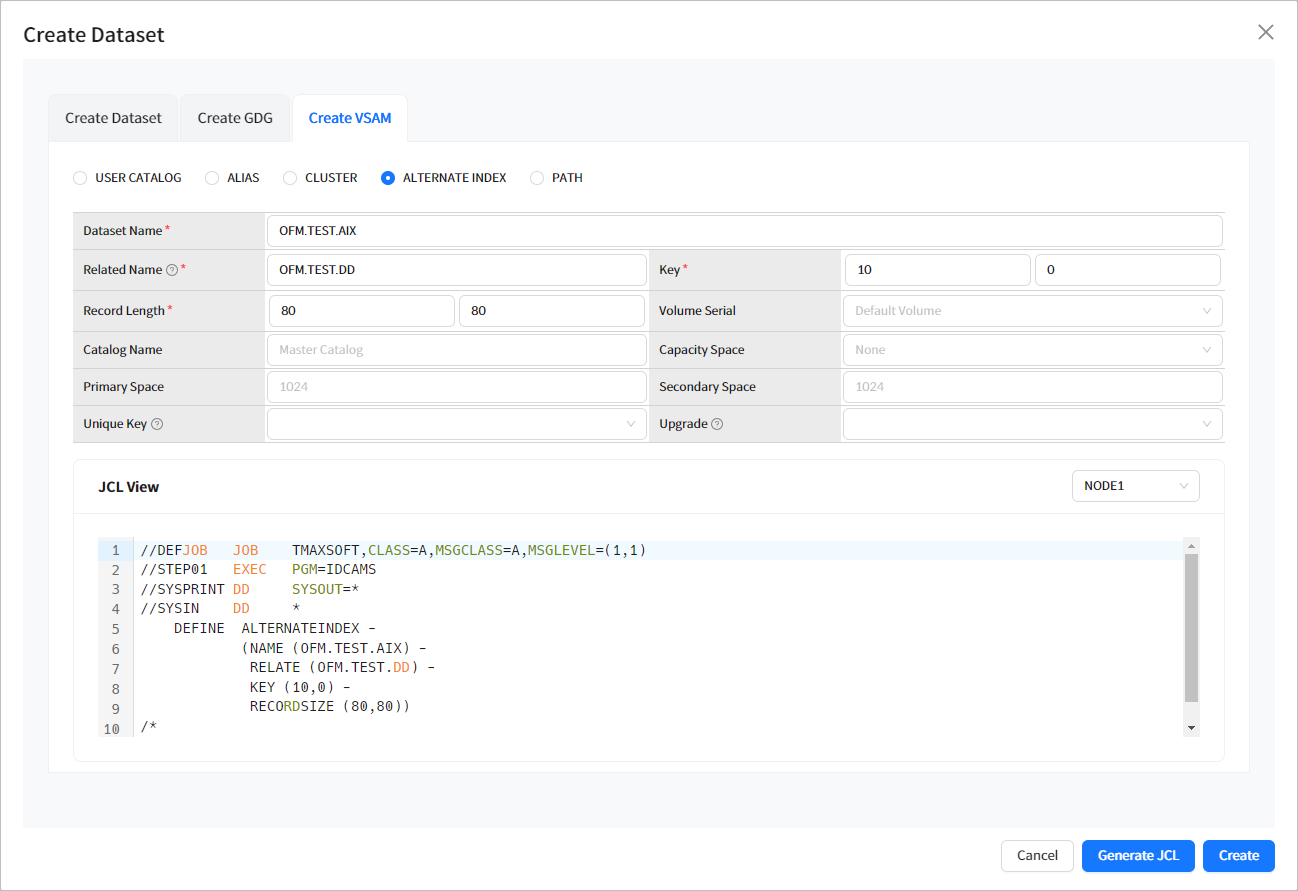 [Base] - Create Dataset - [Create VSAM] Tab (ALTERNATE INDEX)
[Base] - Create Dataset - [Create VSAM] Tab (ALTERNATE INDEX)The following describes each item.
Item Description Dataset Name
AIX dataset name. (Required)
Related Name
Base cluster dataset name associated with the AIX. (Required)
Key
Key position and length of a record in an indexed VSAM dataset.
-
Length (Range: 0-255)
-
Position (Range: 0-32760)
Record Length
Average and maximum length of a record. (Required)
-
Average (Default value: 4086, range: 0-32760)
-
Max (Default value: 32600, range: 0-32760)
Volume Serial
Volume serial name for the dataset.
The default value is set to the 'DEFAULT_VOLSER' key value of the DATASET_DEFAULT section in the ds subject of openframe_base.conf file.
Catalog Name
Name of the catalog for the dataset.
The default value is set to the 'MASCAT_NAME' key value of the ICF_CATALOG section in the ds subject of openframe_base.conf file.
Capacity Space
Select one of:
-
None (Default value)
-
CYLINDERS
-
TRACKS
Primary Space
Initial amount of space allocated for the dataset. (Default value: 1024, range: 0-65535)
Secondary Space
Space allocated for the dataset after the initial allocation. (Default value: 1024)
Unique Key
Option to define alternate index values as unique in the dataset.
Select one of:
-
UNIQUEKEY
-
NOUNIQUEKEY
Upgrade
Option to upgrade alternate indexes whenever its base cluster is modified to keep them up to date.
Select one of:
-
UPGRADE
-
NOUPGRADE
For more information about openframe_base.conf file, refer to OpenFrame Configuration Guide.
-
-
PATH
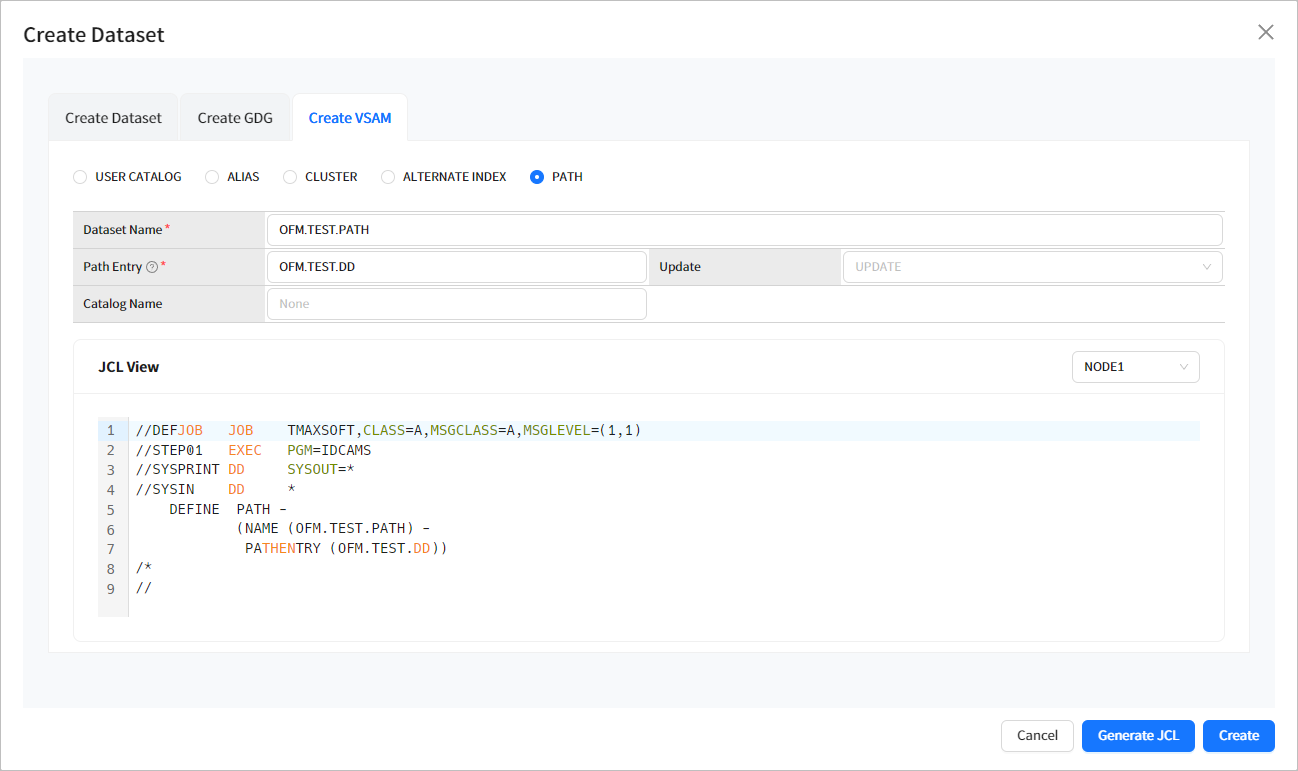 [Base] - Create Dataset - [Create VSAM] Tab (PATH)
[Base] - Create Dataset - [Create VSAM] Tab (PATH)The following describes each item.
Item Description Dataset Name
Path name. (Required)
Path Entry
Specify the AIX dataset name when the path is associated with AIX and base cluster. (Required)
Update
Option to automatically update the upgrade set when the dataset in the base cluster is modified through the path.
-
UPDATE (Default value)
-
NOUPDATE
Catalog Name
Name of the catalog for the path.
-
4.3. Editing a Dataset
Select the dataset from Datasets ([Base] - Datasets) and then click [View/Edit] to open Select Copybook dialogue box, and select Copybook to view and edit a dataset of each column in Dataset View/Edit.

|
To view and edit a dataset, configuration is required including ofsys subject setting in openframe_base.conf file and creation of a relevant directory. For more information, refer to OpenFrame Configuration Guide. |
Select CopyBook on Select Copybook dialog. If you don’t select Copybook, 'CopyBook Format' is deactivated, and if you select 'CopyBook Directory' and 'CopyBook,' 'CopyBook Format' is activated. Select each item, and click [Select].
If the [Select] button is clicked without selecting a copybook, the engine creates a table matching the record length and the user is directly moved to the [Table View] tab([Base] - Dataset View/Edit - [Table View]) on the Dataset View/Edit page.

The following describes each item.
| Item | Description |
|---|---|
CopyBook Format |
Select a copybook format.
|
CopyBook Directory |
Select a directory where copybook is located. The default directory is set to COPYBOOK key value of the WEBDE_CPY_LIB section in the ofsys subject of the openframe_base.conf file. For more information, refer to OpenFrame Configuration Guide). |
CopyBook |
Select a copybook in the selected directory. |
If the selected copybook has multi-layout, clicking [Select] opens the dialog ([Base] - Datasets - View - Copybook Layout) where a layout can be selected.
01 LEVEL FIELD LIST is displayed in the left pane and a copybook of the selected 01 level is displayed in the right pane. To view the entire copybook, select the first field (Entire Layout).Select a level field and click [OK] to retrieve the copybook data with the layout in [Table View] and [Record View] tabs of the Dataset View/Edit page.
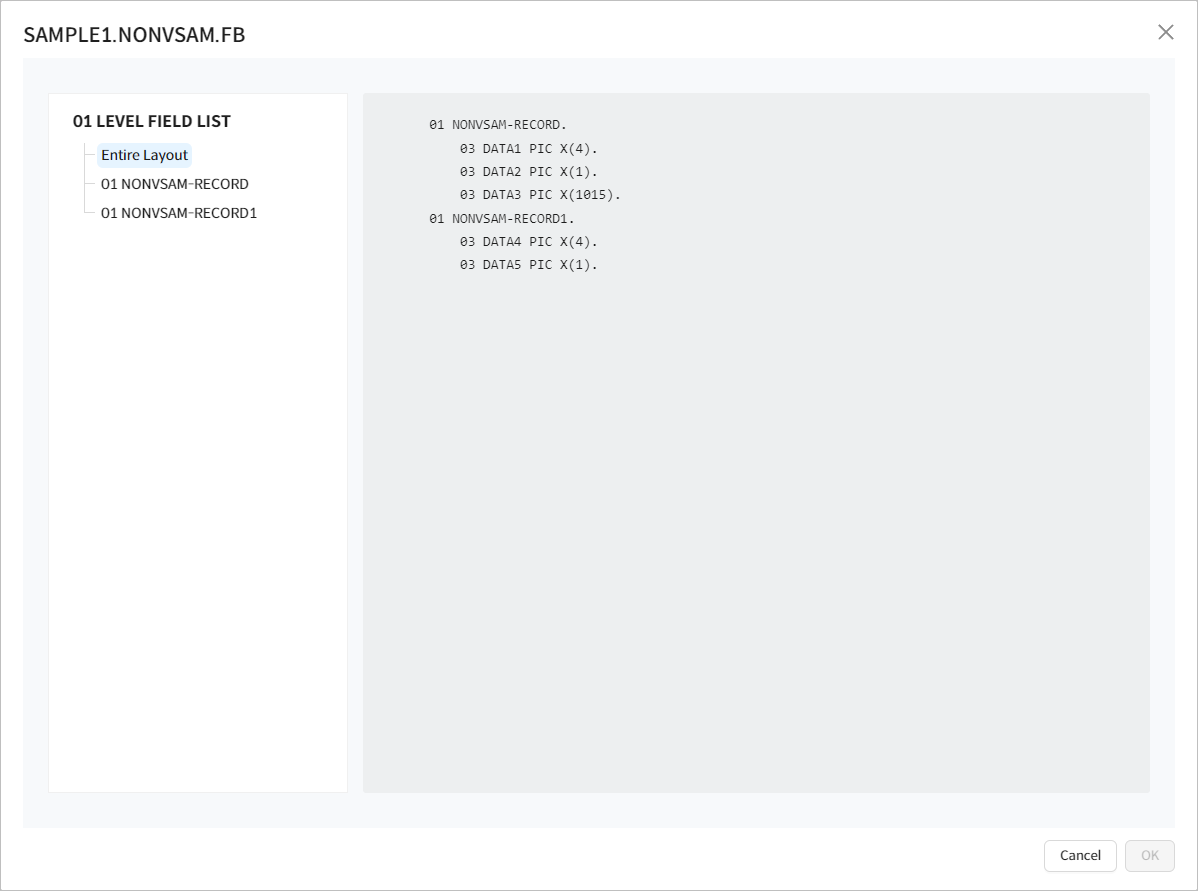
[Table View] Tab
The [Table View] tab in Dataset View/Edit page displays datasets in a selected copybook layout .
If a record has an unprintable character or fails to be converted, it is displayed as a red hexadecimal value. To modify an item of retrieved data, double-click it. The widget for the item becomes an editable text field. Modify the item and press <Enter> to activate [Save].
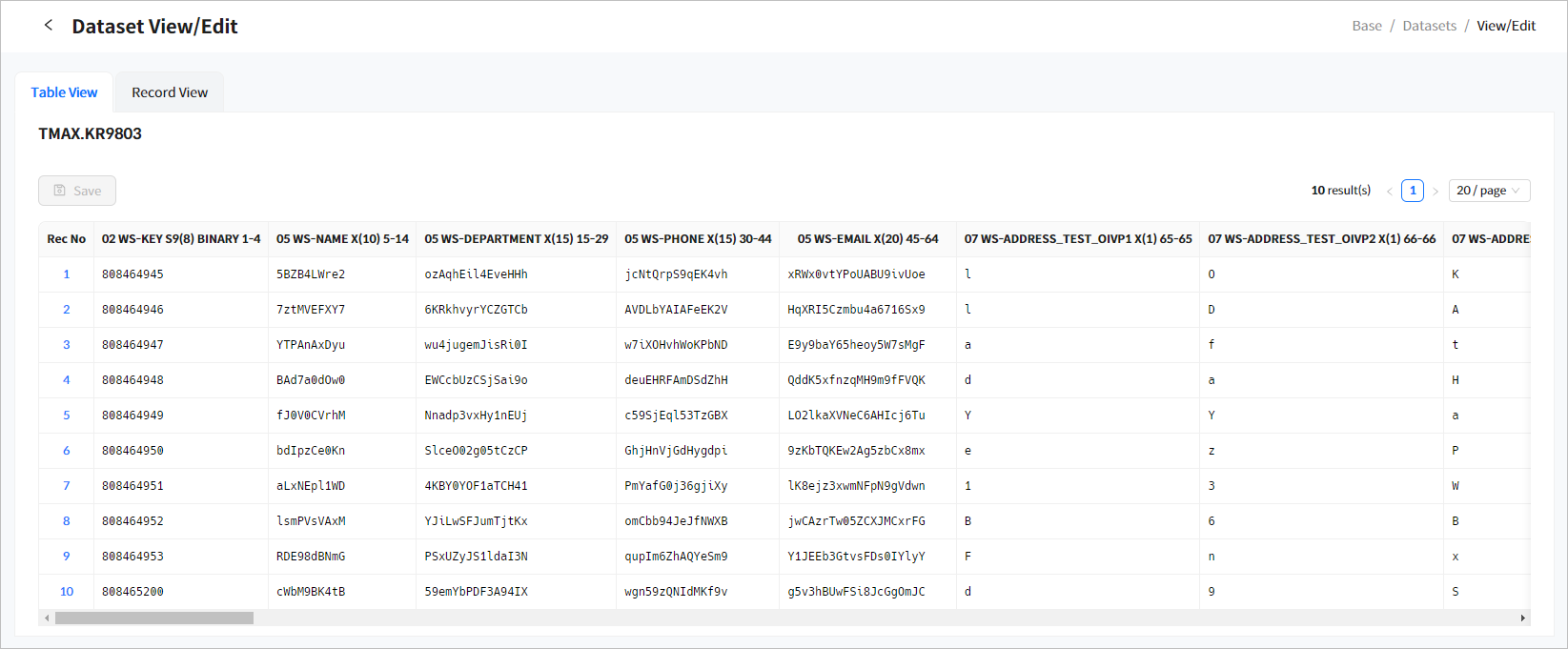
|
For VB data, the pagination function is changed as follows.
|
Clicking [Save] opens the following Edit Dataset dialog that asks whether to save the modification. To apply the modification to the engine, click [Save]. To restore the data before the change, click [Discard Change].
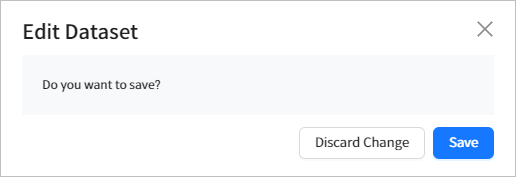
[Record View] Tab
To display datasets as record view, click the [Record View] tab or click the 'Rec No' item in the [Table View] tab on the Dataset View/Edit page .
To check previous or next record, click [<] or [>] in the 'Record Number' item. To check a desired record, enter the record number and click [Search].
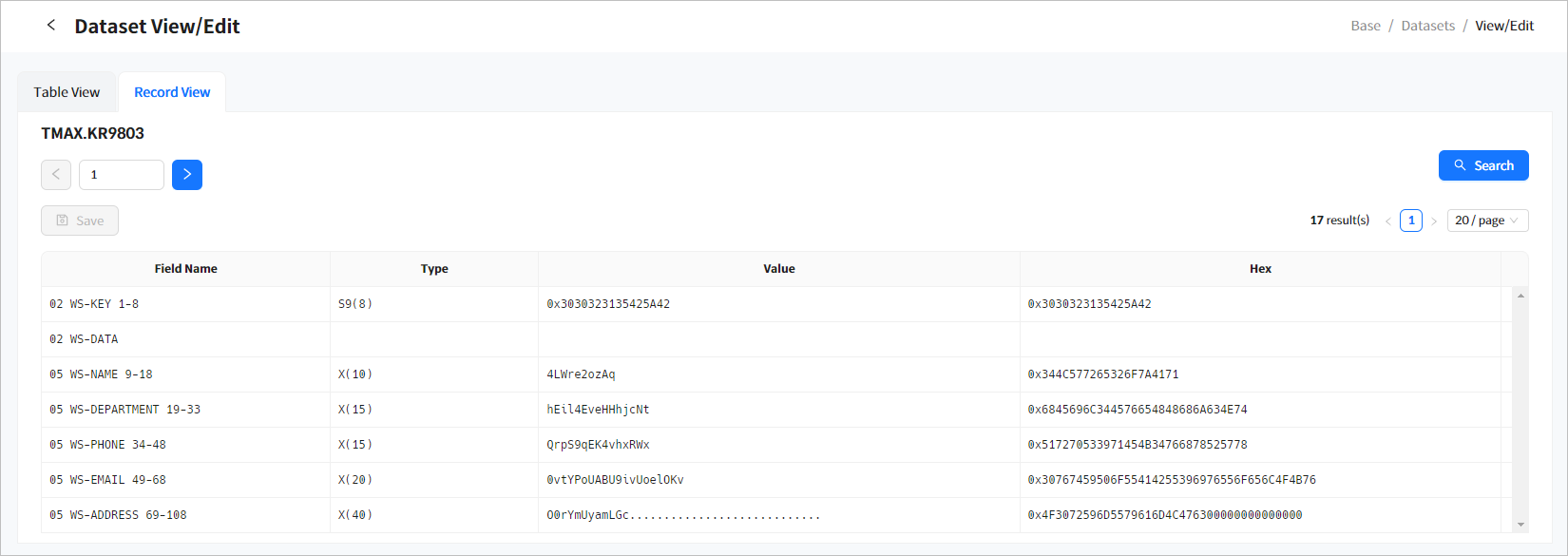
To modify an item of retrieved data, double-click it. The widget for the item becomes an editable textfield. Modify the item and press <Enter> to activate [Save]. Clicking [Save] opens the dialog that asks whether to save the modification ([Base] - Dataset View/Edit - Save). To apply the modification to the engine, click [Save]. To restore the data before the change, click [Discard Change].
4.4. Deleting Datasets
To delete a dataset, select a dataset on the Datasets ([Base] - Datasets). Clicking the button opens a dialog that asks whether to delete a dataset. If you click [OK], the dataset is deleted, and the result message is displayed.

Deleting Multiple Datasets
To delete multiple datasets, select the datasets on Datasets, and then click [Delete].
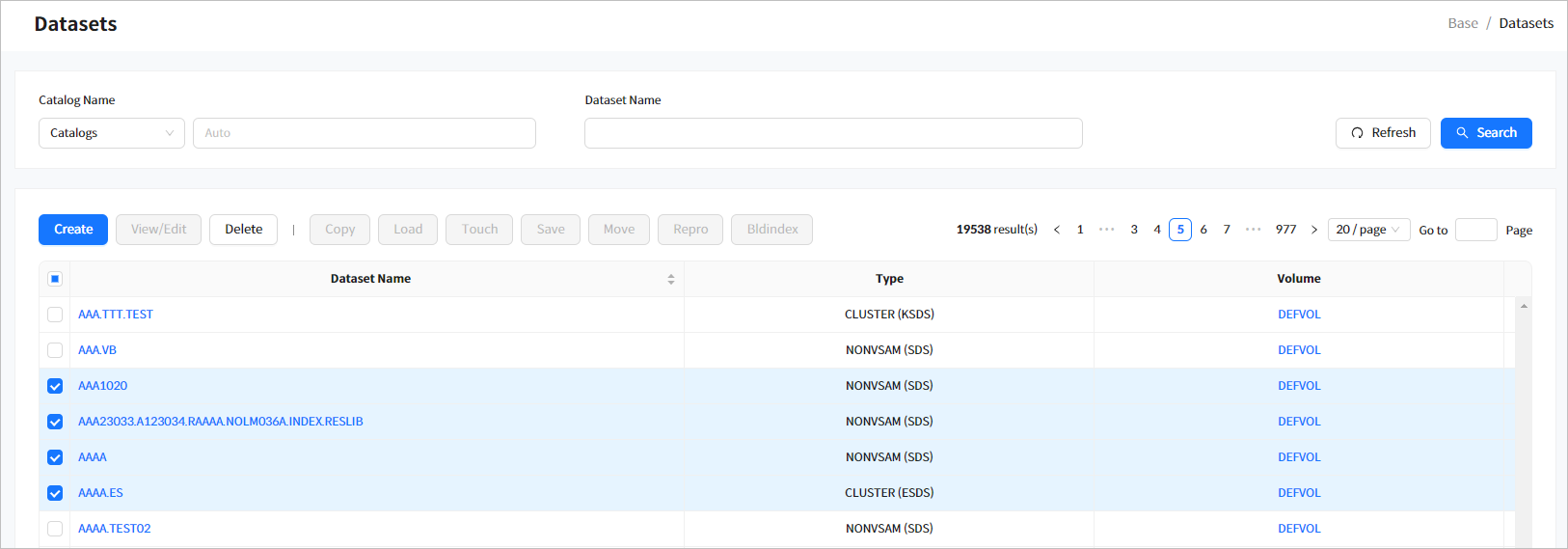
-
NONVSAM (PDS), NONVSAM (SDS), and GDG Datasets
Select datasets by checking its check box in the Datasets list and then click [Delete] above the dataset list. When a confirmation dialog box opens, click [OK].
To check and delete PDS members, go to the Dataset Details page for NONVSAM (PDS).
 [Base] - Datasets - Delete NONVSAM or GDG Dataset
[Base] - Datasets - Delete NONVSAM or GDG Dataset -
VSAM Datasets
You cannot delete multiple VSAM datasets. If you select multiple datasets and then click [Delete] above the dataset list, the following error message is displayed. Click [OK] to close the message box.
 [Base] - Datasets - Multi Delete Error Message
[Base] - Datasets - Multi Delete Error MessageSelect one checkbox for the dataset to delete and then click [Delete] above the dataset list. This displays the following dialog.
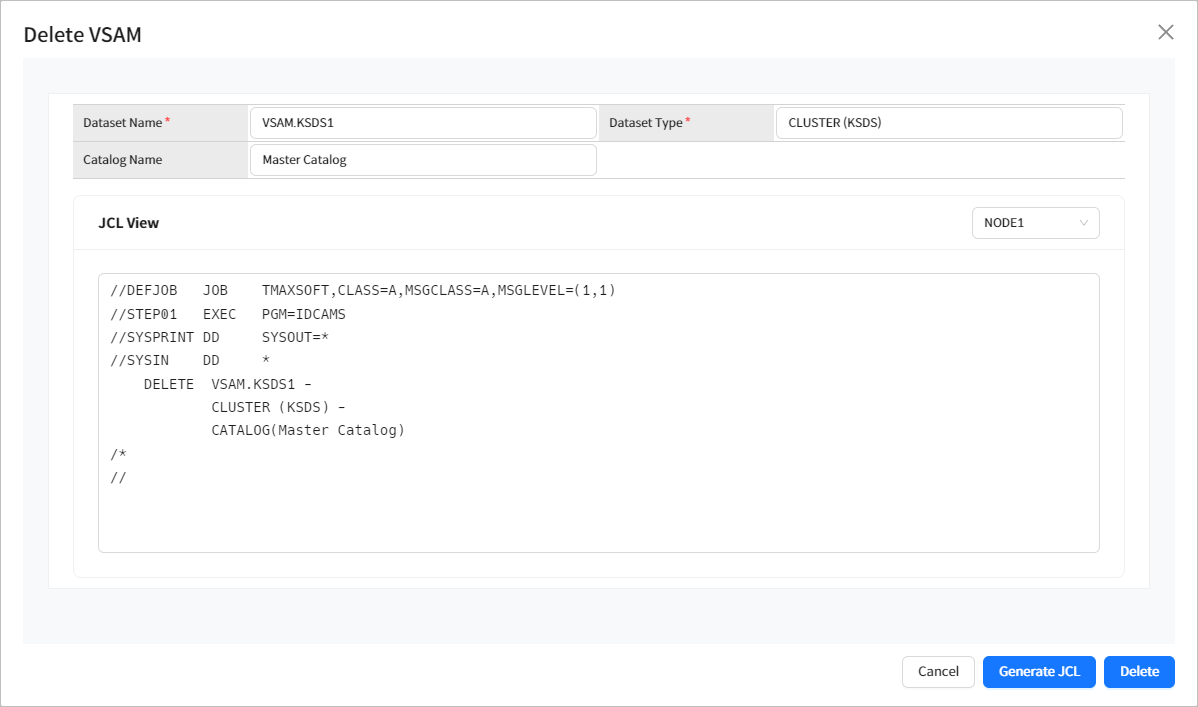 [Base] - Datasets - Delete VSAM Dataset
[Base] - Datasets - Delete VSAM DatasetEnter the required fields, and then click [Generate JCL] to insert JCL to delete the VSAM in the JCL View textbox and enable the [Delete] button. Click [Delete] to submit the job and the dataset is deleted by the idcams tool.
For more detailed information, refer to the "1.4. IDCAMS" section in OpenFrame Utility Reference Guide.
4.5. Managing Datasets
To manage datasets, use buttons above the dataset list in Datasets ([Base] - Datasets).

The following describes each button.
-
[Copy] button
Creates a copy of the dataset. When the following dialog box is displayed, enter the required values and then click [Copy]. A confirmation message is displayed when the copying is complete.

-
[Load] and [Force Load] buttons
Loads the dataset as a UNIX file into the temporary directory set in OpenFrame. Clicking the [Load] button opens the following load confirmation box.
When you check 'Force load…' and click [OK], the dataset is overwritten by the selected dataset, although the dataset was already loaded. Once loading is complete, it can be edited from the temporary directory using the dataset edit tool.
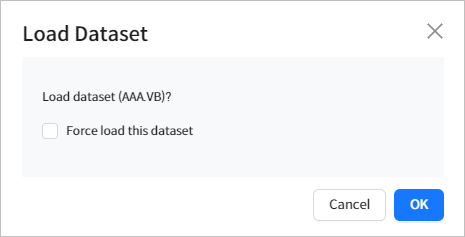
-
[Touch] button
Changes the last accessed date of the dataset. Clicking the [Touch] button opens the following confirmation box. .
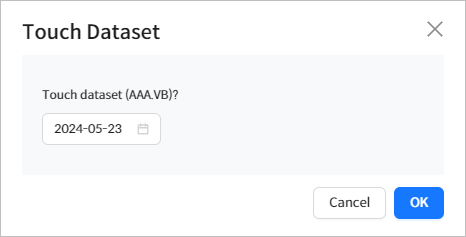
Click the calendar icon to open the date picker control. When you select the desired date and then click [OK], a confirmation message is displayed. A future date is not allowed.
-
[Save] button
Saves the dataset loaded into the temporary directory as the original dataset. Clicking [Save] opens the following dialog box.
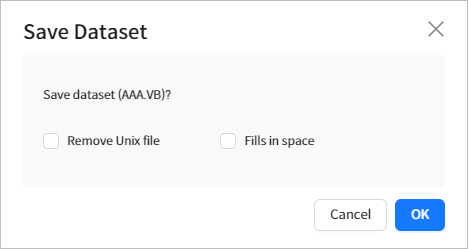
If you check 'Remove Unix file' and click [OK], the UNIX file saved in the temporary directory is deleted after the dataset is saved. If you check 'Fills in space' and click [OK] for fixed length records (RECFM=FB), the remaining space of a short record is filled .
-
[Move] button
Moves the dataset (change name). If the menu is selected, the following dialog box appears. Enter the required fields, and then click [Move]. When the dataset is moved, the result message is displayed.

-
[Repro] button
Copies records from VSAM dataset to another VSAM dataset.
Enter the required fields, and then click [Create] to insert JCL to copy VSAM records in the JCL View textbox and enable the [Submit] button. Click [Submit] to submit the job to copy the dataset records.
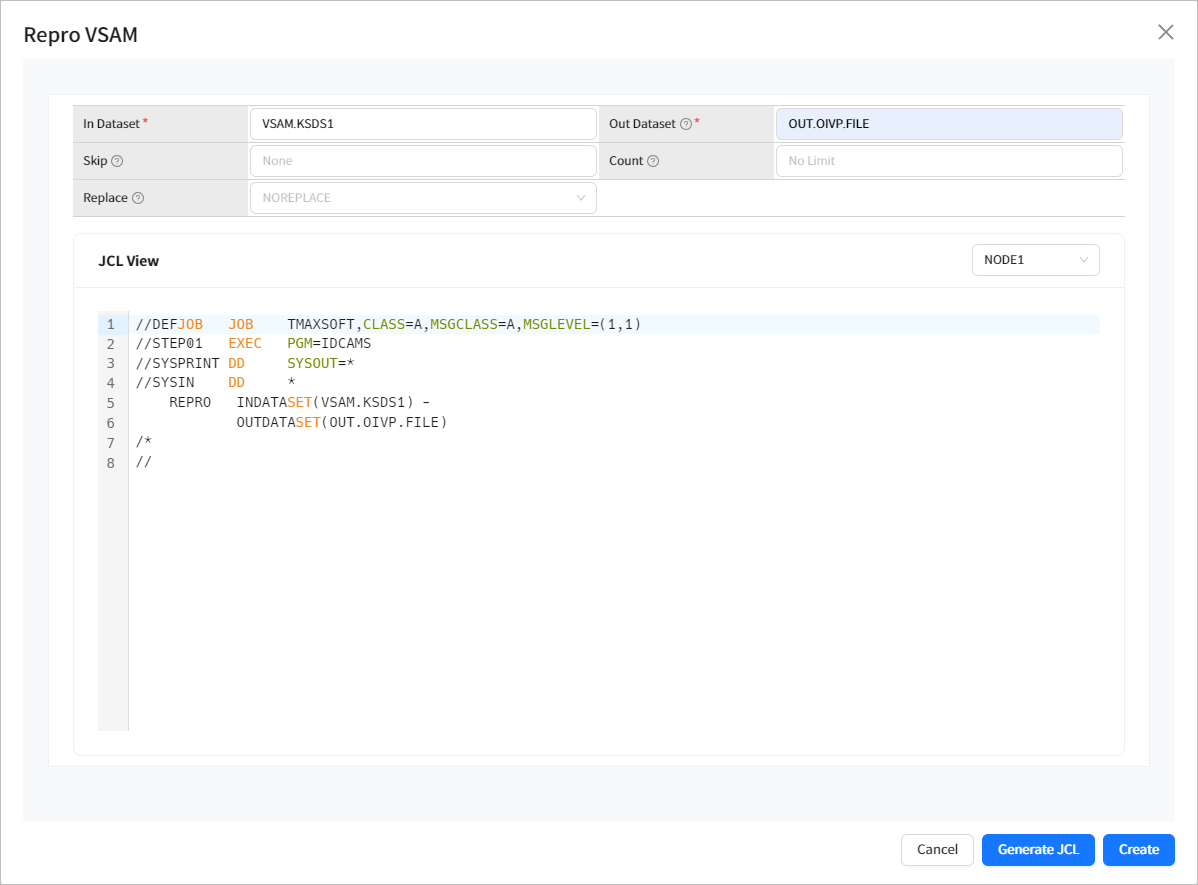
The following describes each item.
Item Description In Dataset
Source dataset.
Out Dataset
Target dataset. (Required)
Skip
Number of records to skip before copying the records. (Default value: None)
Count
Number of records to copy. (Default value: No Limit)
Replace
Option to overwrite existing records in the target dataset.
-
REPLACE
-
NOREPLACE (Default value)
-
-
[Bldindex] button
Builds alternate indexes on VSAM. Enter the required fields, and then click [Create] to insert JCL to build indexes in the JCL View textbox and enable the [Submit] button. Click [Submit] to submit the job to build alternate indexes.
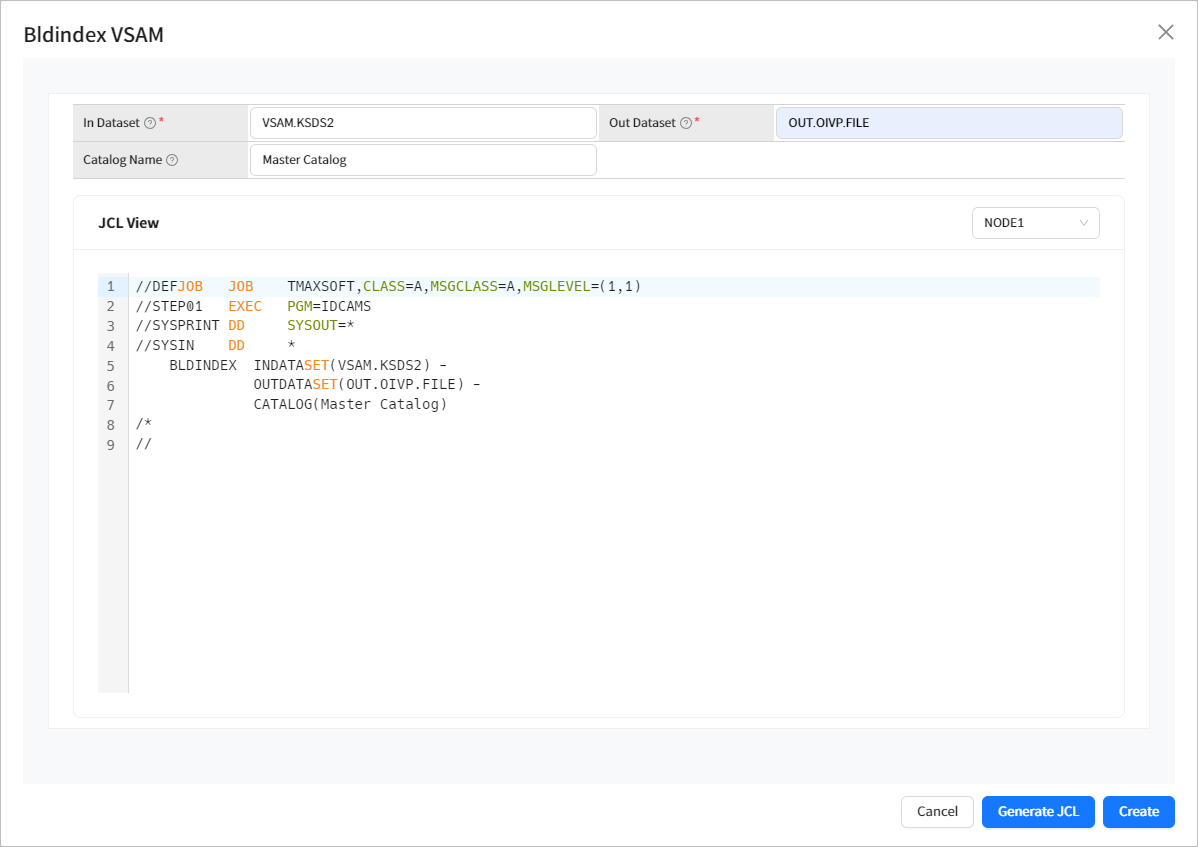
The following describes each item.
Item Description In Dataset
Base cluster to extract record from. (Required)
Out Dataset
Alternate index name. (Required)
Catalog Name
Catalog that includes the specified datasets. (Default value: Auto)
5. Locks
Click [Locks] from the navigation pane to display a list of locks set in an OpenFrame/Batch or OSC system.
Enter the search conditions from the Locks page and then click [Search] to display the results. Only locks that meet all specified conditions are returned. Click [Refresh] to refresh the list.
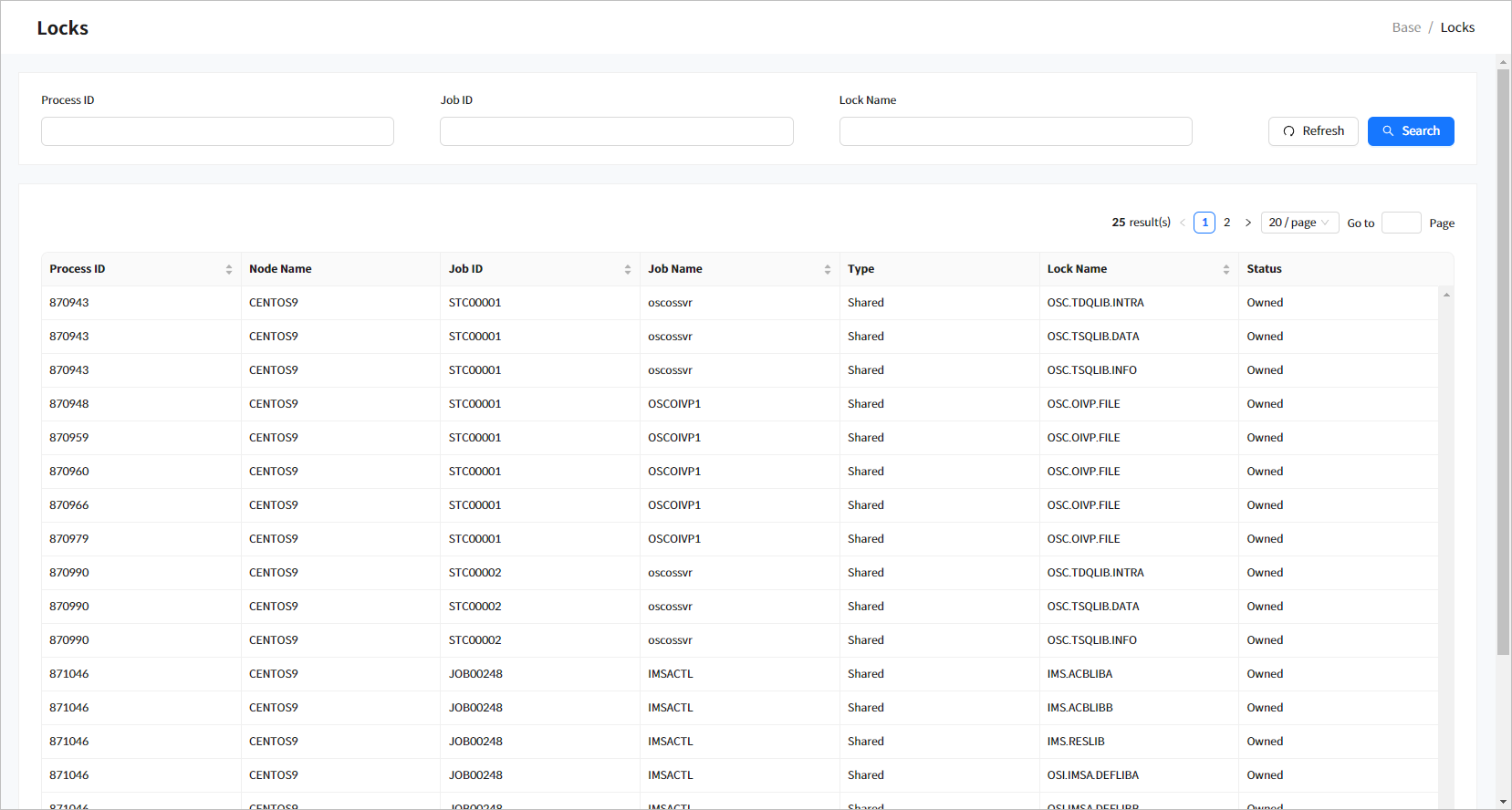
-
Search Conditions
The following describes the lock search conditions.
Item Description Process ID
Process ID holding the lock (Exact search method).
Job ID
JOBID of the process holding the lock. Up to 8 characters allowed (LIKE (Prefix) search method).
Lock Name
Dataset name.
-
Search Results
The following describes the search result columns.
Column Description Process ID
Process ID holding the lock.
Node Name
Node name of the process holding the lock.
Job ID
JOBID of the process holding the lock. JOBID is assigned when JCL is executed in OpenFrame/Batch system.
Job Name
Job name of the process holding the lock.
Either the name of the process running with the lock or the tool name when dstool is executed is displayed. If the tool name is displayed, Job ID is not displayed.
Type
Lock type.
-
Shared
-
Exclusive
Lock Name
Name of the dataset on which the lock is placed.
Status
Lock status.
-
Owned
-
Wait
-
6. Logs
Click [Logs] from the navigation pane to go to the Logs page where logs are displayed under their corresponding folder.
The Logs page consists of the following tabs.
| Tab | Description |
|---|---|
[Job Logs] |
Job execution logs. |
[Submit Logs] |
Job logs generated after a job is submitted. |
[Tmax ulog] |
Logs from OpenFrame related servers running on Tmax. |
[Tmax slog] |
Tmax logs. |
[OpenFrame Logs] |
OpenFrame logs from creating and allocating datasets and related to security (saf). |
[Commands Logs] |
OpenFrame tool (dstool, osc cmd, tjesmgr, and textrun) logs. |
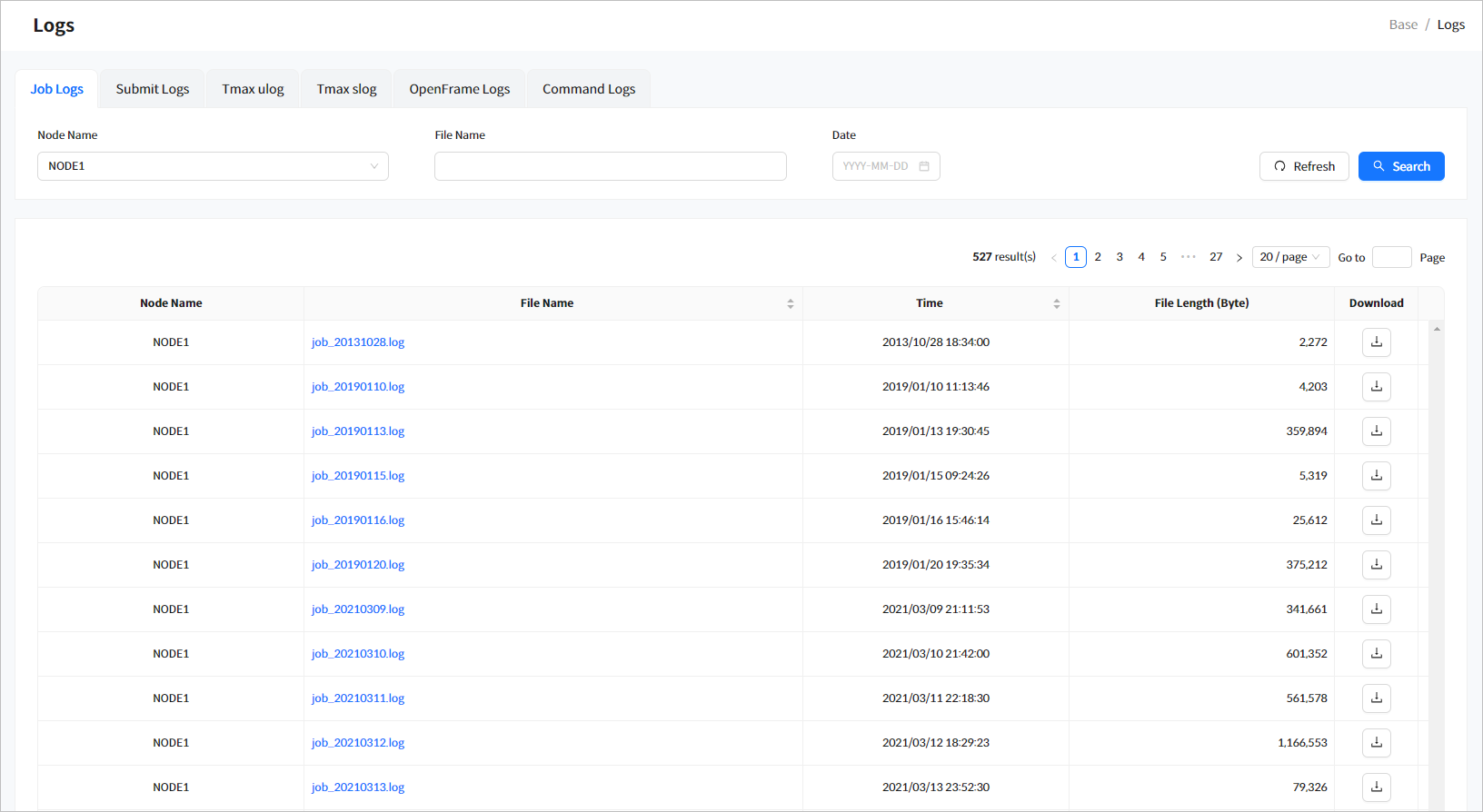
The following describes search conditions and items of each tab. All log tabs display the same log items.
-
Search Conditions
The following describes the log search conditions (Wildcard (*) search method, However, the search like A*C is not allowed).
Item Description Node Name
Node name.
File Name
Log file name.
Date
Date when the log file was modified.
-
Search Results
The following describes the search result columns.
Column Description Node Name
Node name of the log file.
File Name
Log file name.
Clicking a log file name goes to the Log Details page ([Base] - Logs - Log Details). For more information about the page, refer to Log Details Page.
Time
Date when the log file was created or modified.
File Length (Byte)
Log file size. (Unit: bytes)
Download
Click
 ([Download]) to download the log file.
([Download]) to download the log file.You can only download log files under 50 MB, given the performance of the browser and OpenFrame engine.
6.1. Log Details Page
To go to the Log Details page ([Base] - Logs), click 'File Name' from the list in Logs ([Base] - Logs). The page shows 100 KB of most recent log messages. Click the [<] icon before the page title to return to the previous page.
If there are more logs, [Load More] at the top is enabled and disabled otherwise. Click this to retrieve additional 100 KB of log messages.
To update a log file, click [Refresh] at the right of the file name. To download the log file, click [Download].
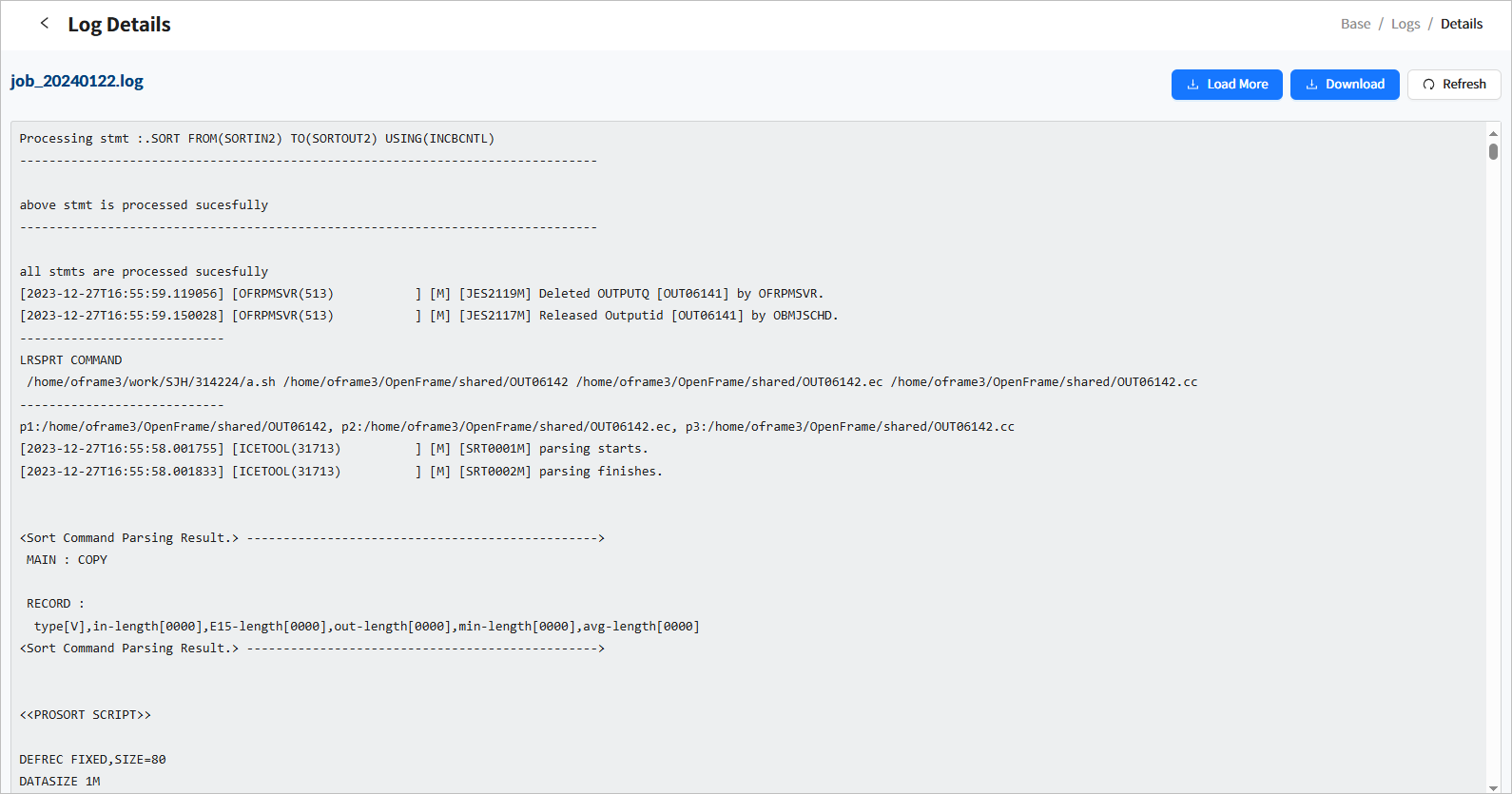
|
You can only download log files under 50 MB, given the performance of the browser and OpenFrame engine. |
7. Console
Click [Console] from the navigation pane to go to the Console page. You can view messages generated during JCL or COBOL executions, and check or reply to the message history. The Console page consists of the [Console], [History], [Reply] tabs.
7.1. [Console] Tab
The [Console] tab displays logs that occurred on the server during JCL and COBOL program executions.
To send a reply, click a message from the list, enter the reply in the text box at the bottom, and then press the <Enter> key or click [Send]. The console messages are only maintained while the Console tab is active, and will be deleted when the user moves to another tab or page. OpenFrame saves the messages in a history file for the current date, and they can be retrieved from the [History] tab. For more information, refer to [History] Tab.
The following figure shows the console page with log messages from a server on which a COBOL test application is running.
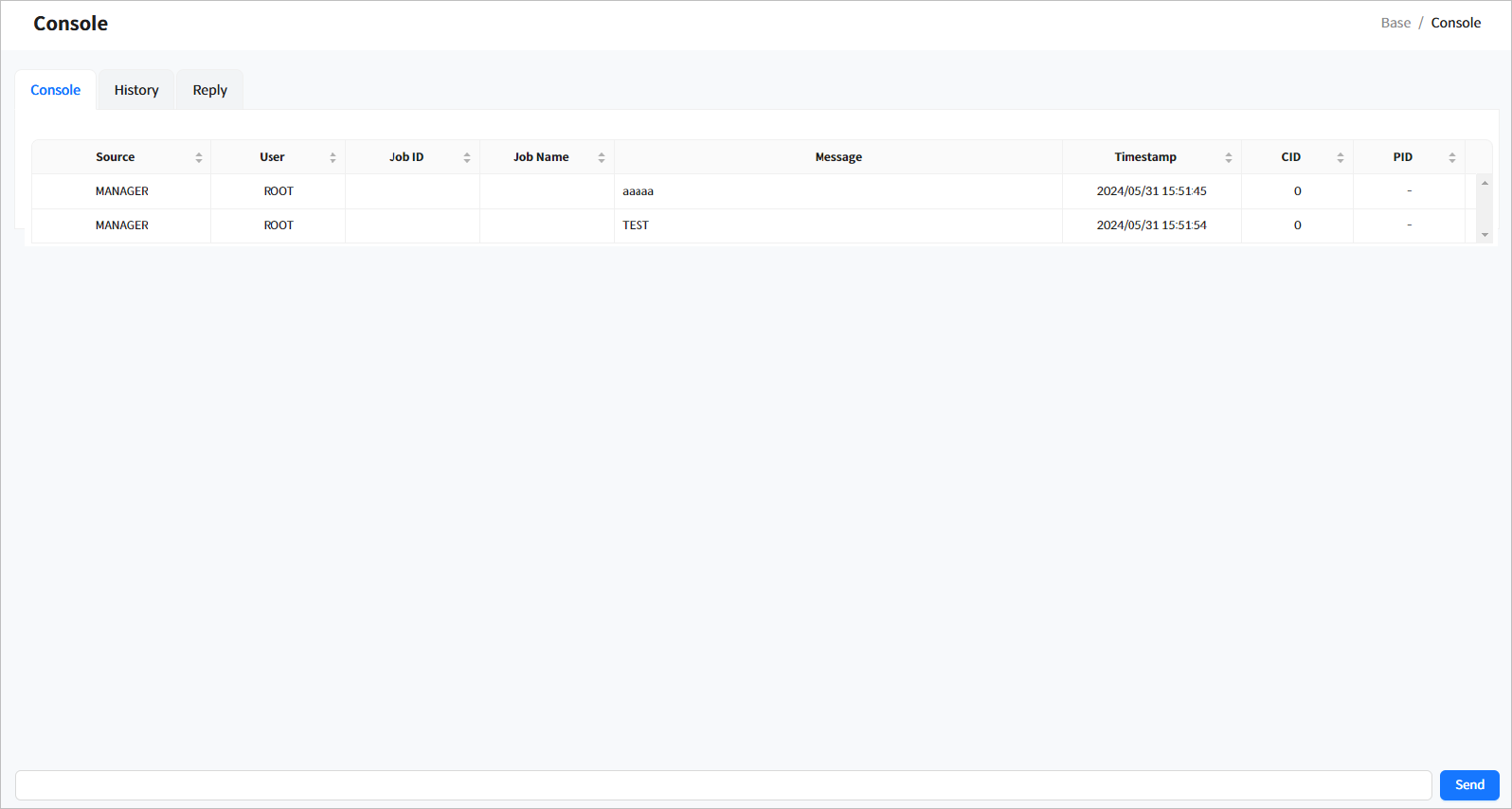
-
Search Results
The following describes the search result columns.
Column Description Source
System that logged the message.
User
User account under which the log was generated.
Job ID
Job ID to reply to when the log source is TCONMGR.
Job Name
Job name.
Message
Message sent to/from a program.
Timestamp
Date and time when the message was logged.
CID
Console ID.
PID
Process ID. If the 'Source' is 'MANAGER', a hyphen (-) is displayed.
7.2. [History] Tab
Click the History tab in the Console page to search for console messages. Enter the search conditions from the Console History Search page and then click [Search] to display the results.
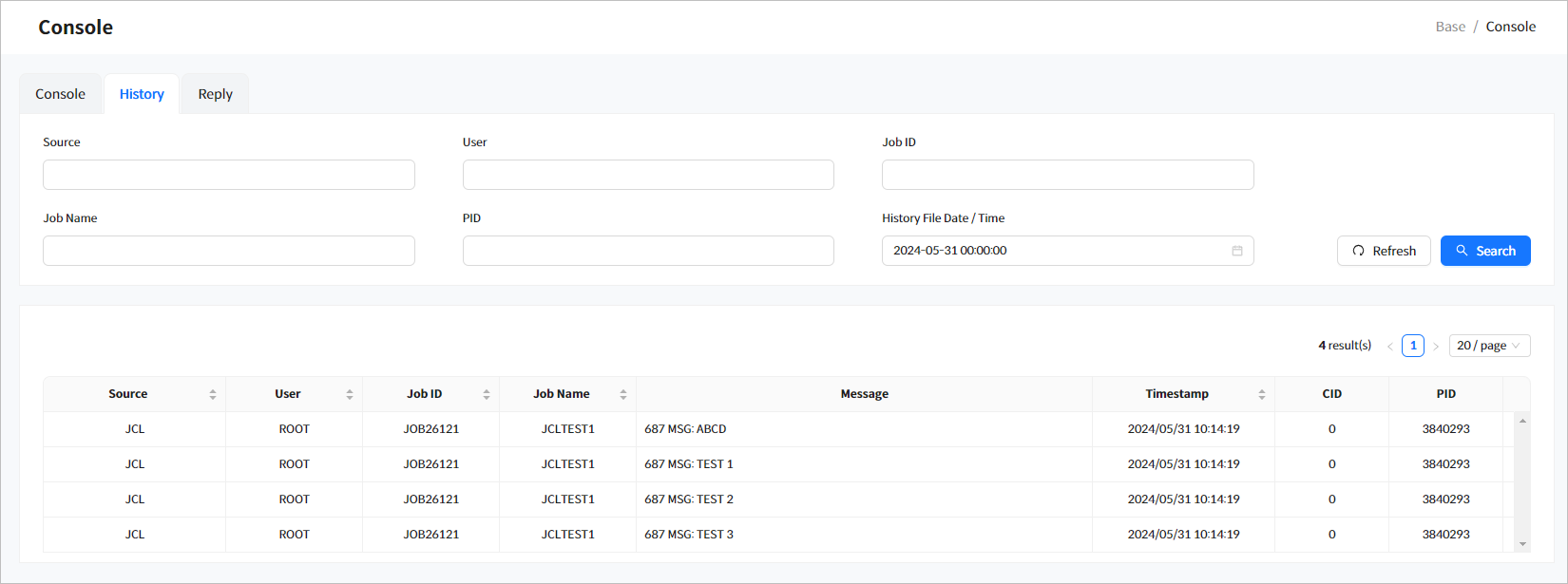
-
Search Conditions
The following describes the console message search conditions.
Item Description Source
System that logged the message.
User
User under which the program executed.
Job ID
Job ID.
Job Name
Job name.
PID
Process ID.
History File Date/Time
Creation date of the history file to be retrieved. Messages with time stamped between the specified time and 24:00 are retrieved from the history file.
-
Search Results
The following describes the search result columns.
Column Description Source
System that logged the message.
-
MANAGER: OpenFrame Manager.
-
COBOL: OpenFrame.
-
TCONMGR: OpenFrame tconmgr.
User
User under which the program executed.
Job ID
Job ID.
Job Name
Job name.
Message
Message sent to/from a program.
Timestamp
Date and time when the message was sent.
CID
Console ID.
PID
Process ID. If the Source is 'MANAGER', a hyphen (-) is displayed.
-
7.3. [Reply] Tab
Click the [Reply] tab in the Console page to search for messages that require a reply. The Console Reply list is automatically populated when the tab is selected.
Select a message by checking its check box in the list, enter a reply message in the text box at the bottom, and then press <Enter> or click [Send]. A reply can be sent for multiple messages by checking multiple rows in the list. Click [Refresh] to refresh the list. Go back to the History tab to check if the reply message (time stamped as the current date) has been sent successfully. Click [Msg History] to check console messages outputted by the Job.
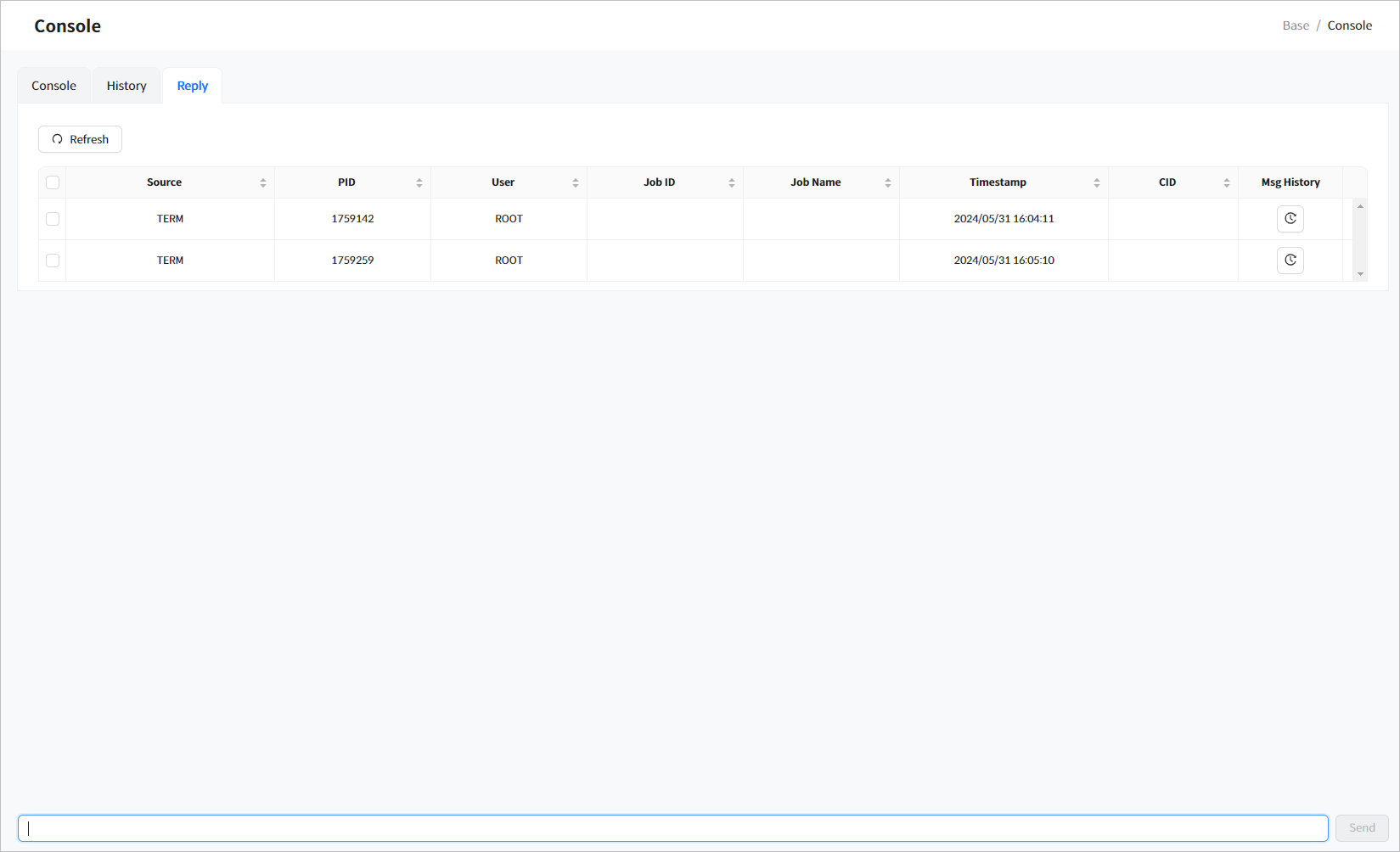
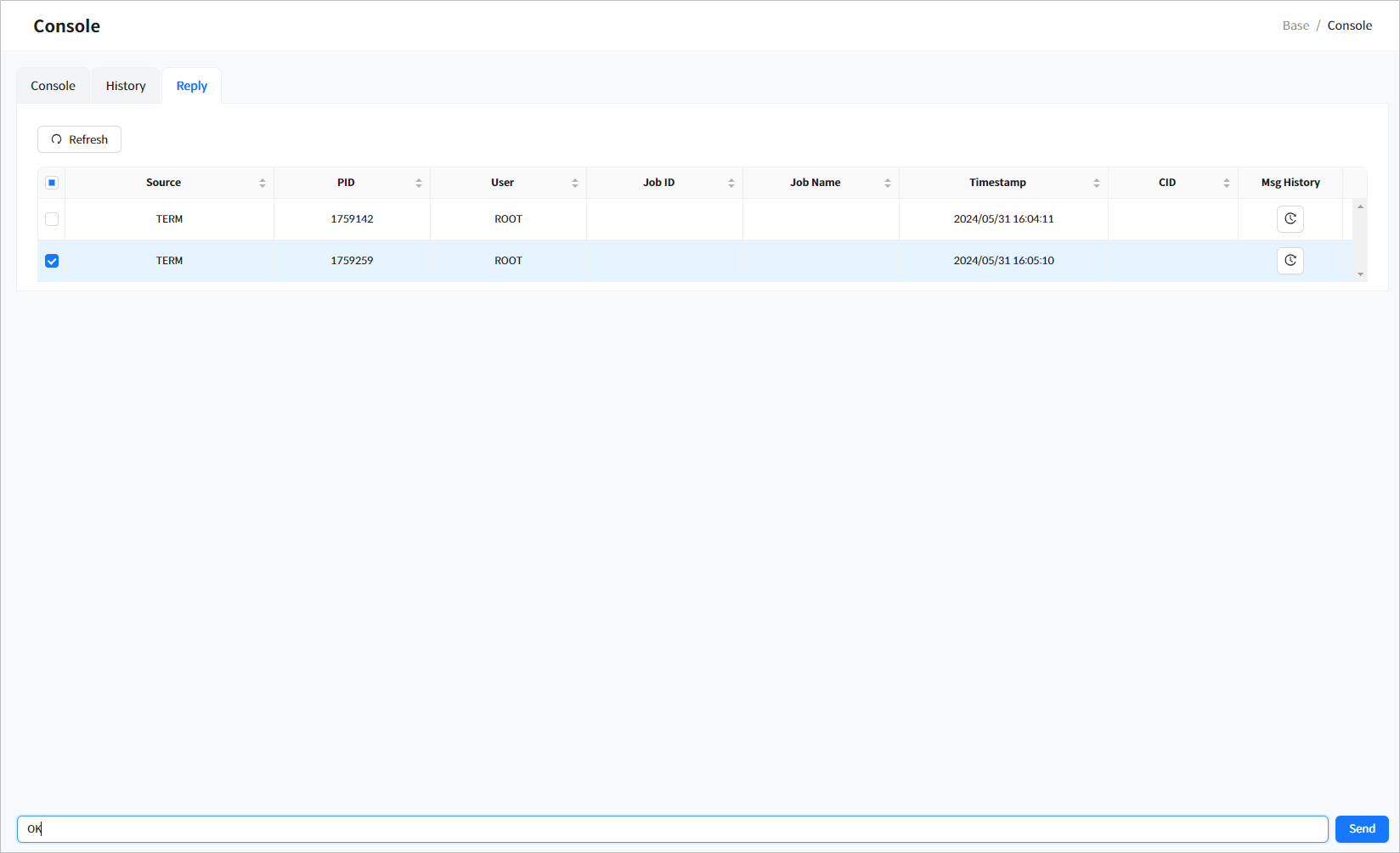
8. Command
Click [Command] from the navigation pane to use OpenFrame tool commands or Linux shell commands specified in the 'COMMAND_LIST' key under the [OFRUISVR] section in the dstool subject of the openframe_base.conf file. For more information about the openframe_base.conf file, refer to OpenFrame Configuration Guide.
<openframe_base.conf>
--------------------------------------------------------------------------------------------- SUBJECT | SECTION | KEY | TYPE | DEFAULT_VALUE | VALUE --------------------------------------------------------------------------------------------- dstool | OFRUISVR | COMMAND_LIST | 2 | idcams,ls,offile | idcams,ls,offile : : : : : : : : : : : :
|
It is recommended that you do not use commands that can have a significant impact on your system. You cannot use commands from tools that accept input internally, such as tjesmgr or tconmgr. |
If you use dstool from the Command menu, the number of processes in the ofruisvr server must be greater than one in order to use a command. This is because separate processes must be started; one for sending the command and another for executing the command. For more information on how to configure Tmax, refer to Tmax Administrator’s Guide.
To execute a command, select the command from the Select command dropdown list and enter the command option in the text box and then click Send. To reset the page, click [Clear].
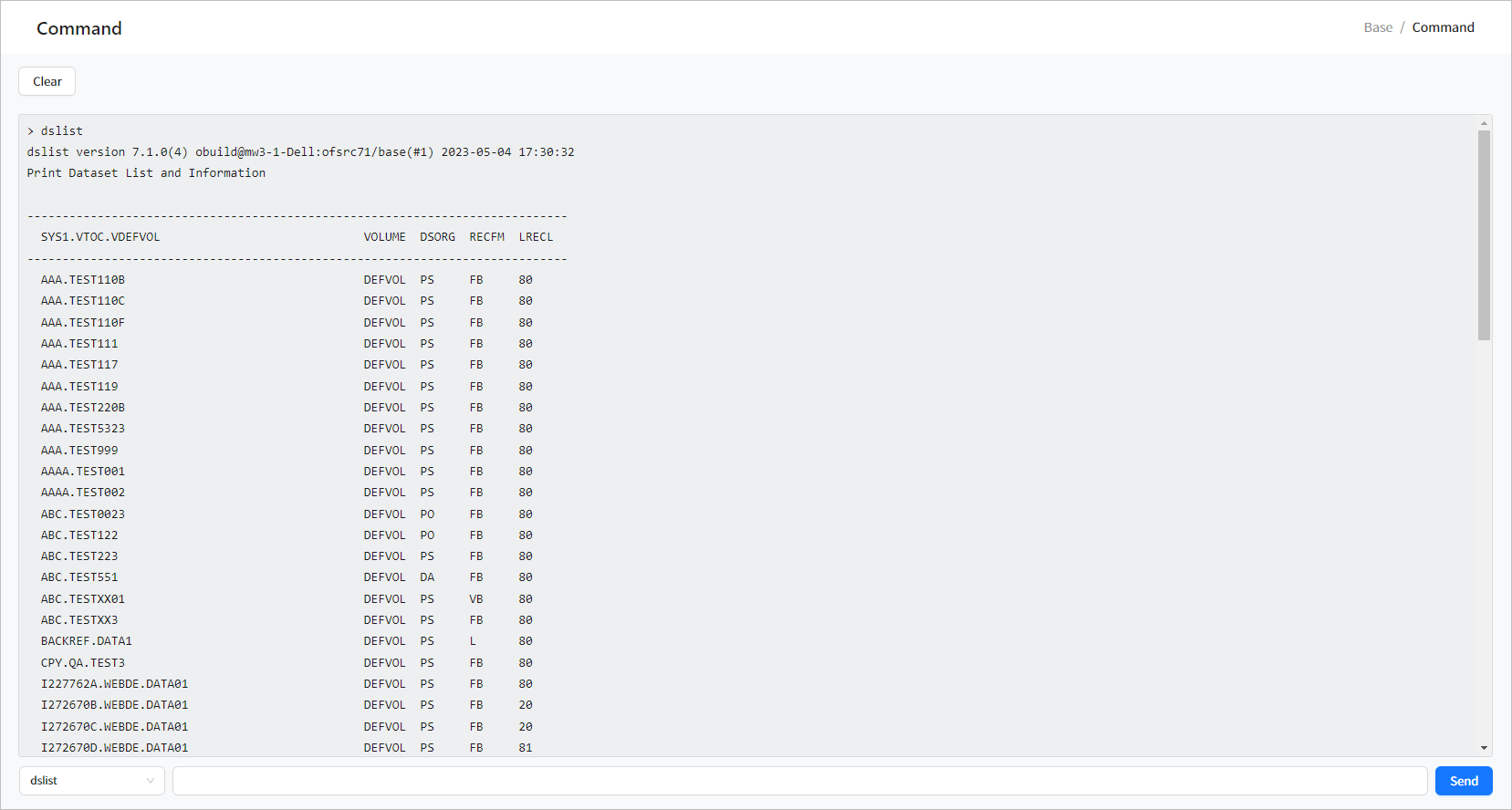
|
The [Command] menu can have functional restrictions based on TACF permission. If the CM.COMMAND resource is defined in the OFMANAGER class, only users with the READ permission can access to the [Command] menu. If not defined, all users can access the menu. |
